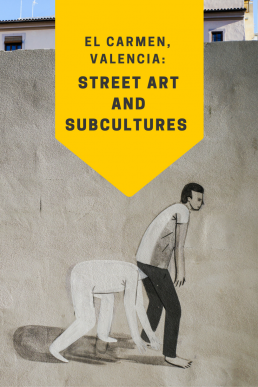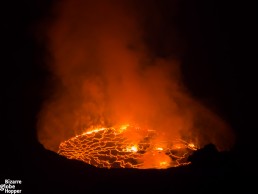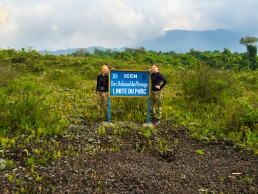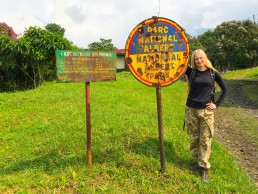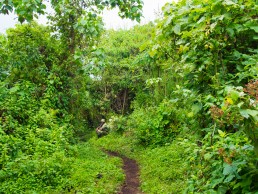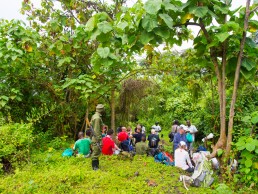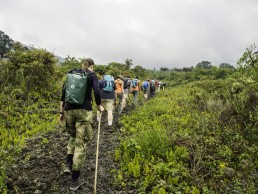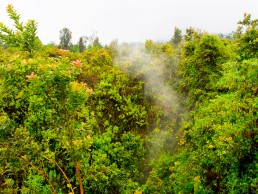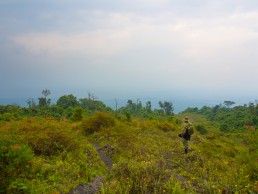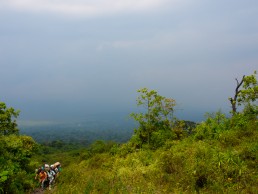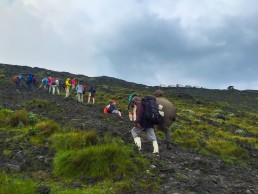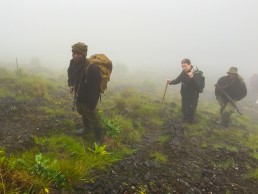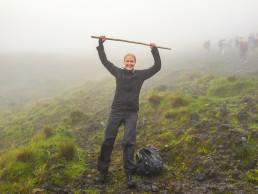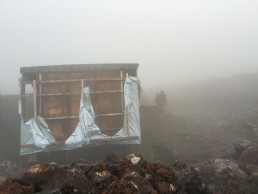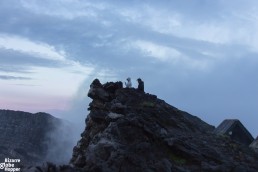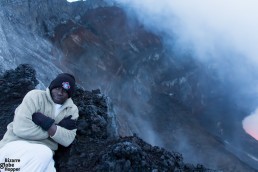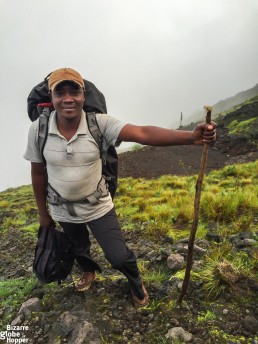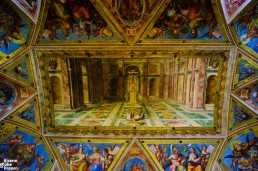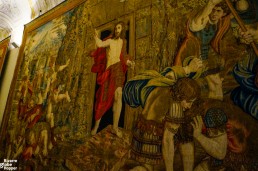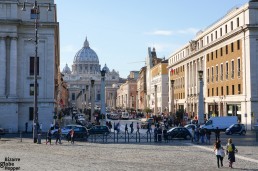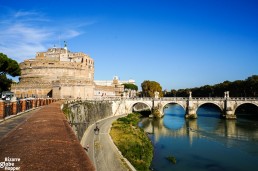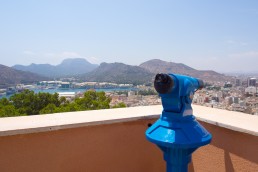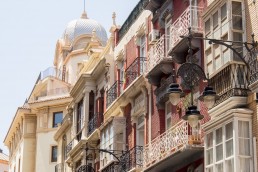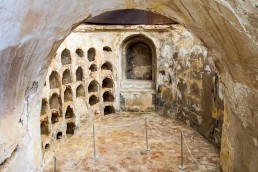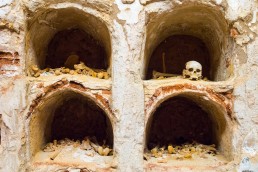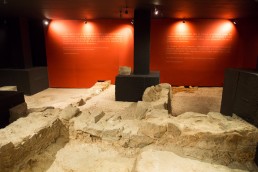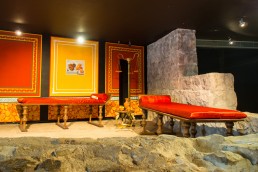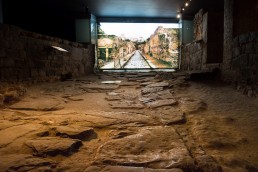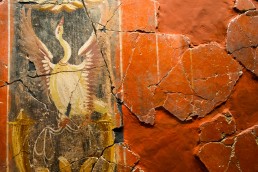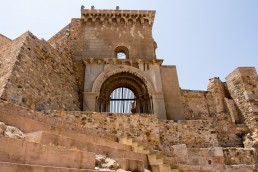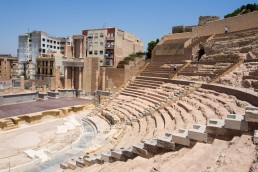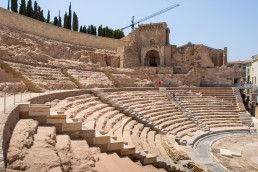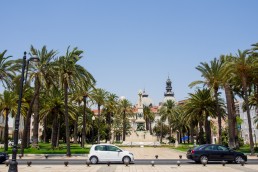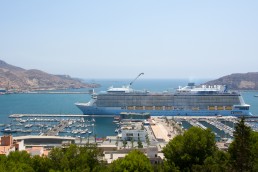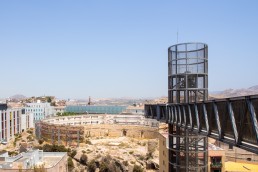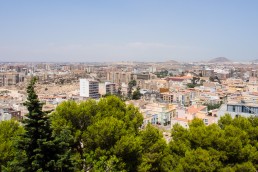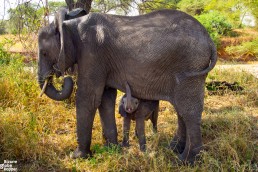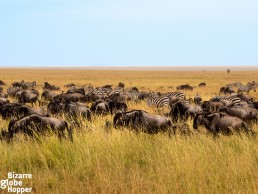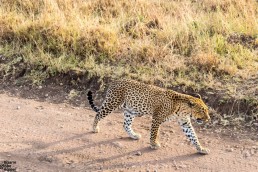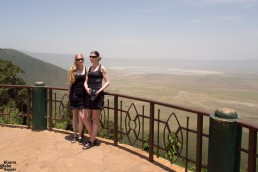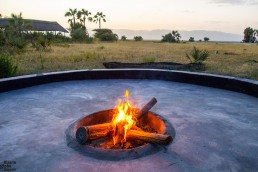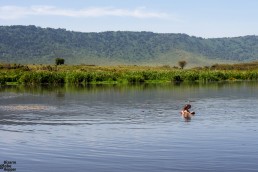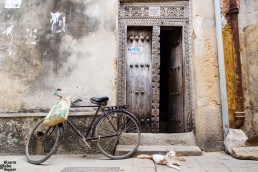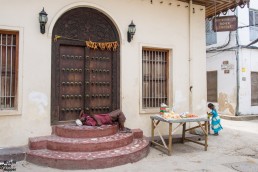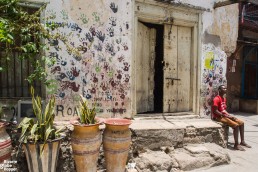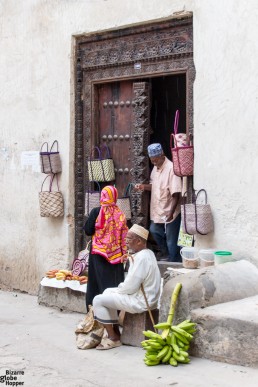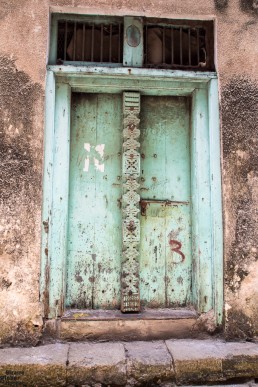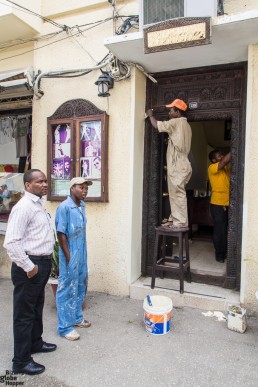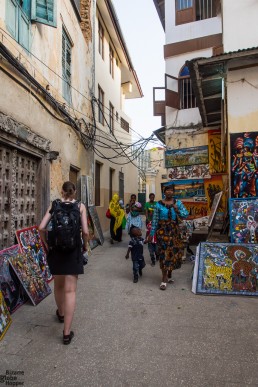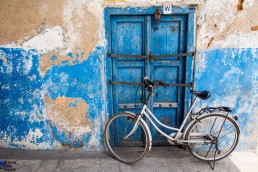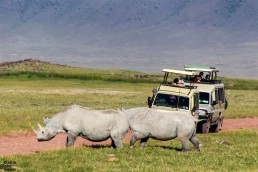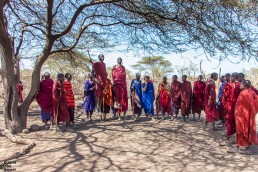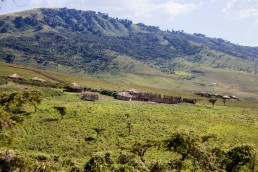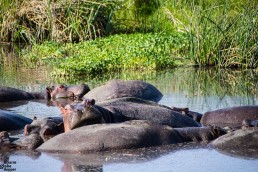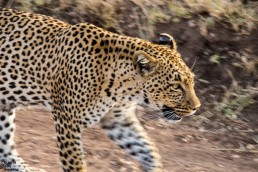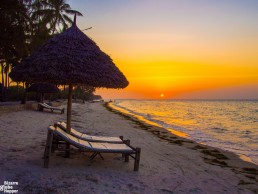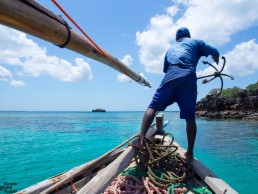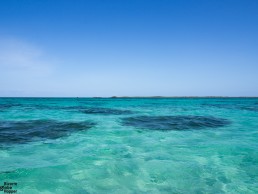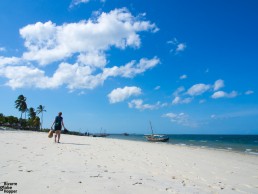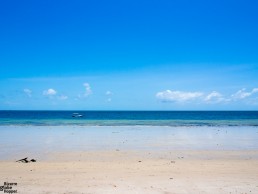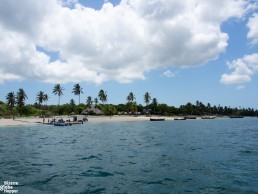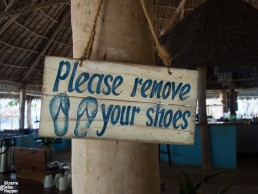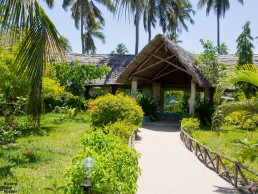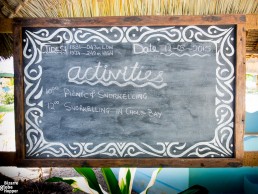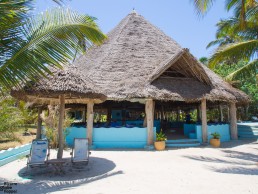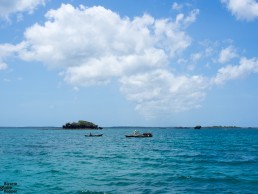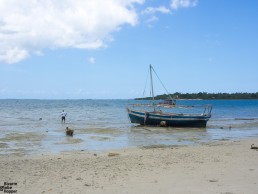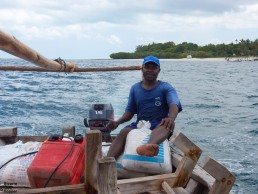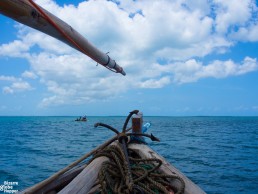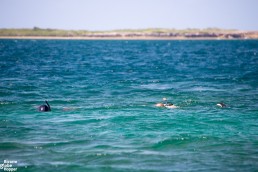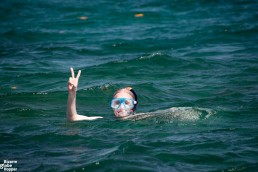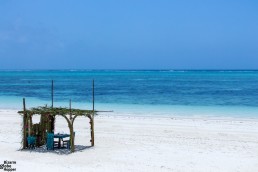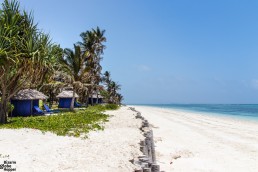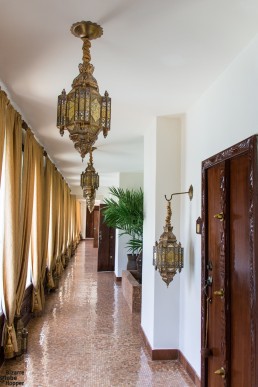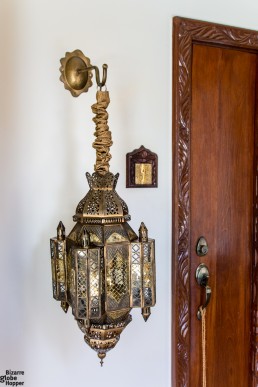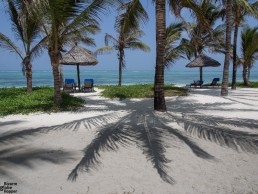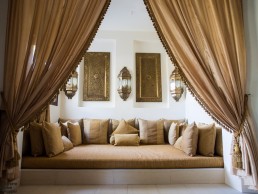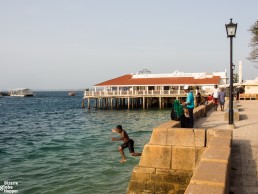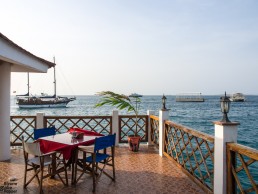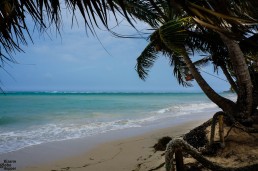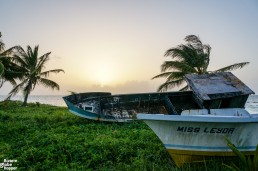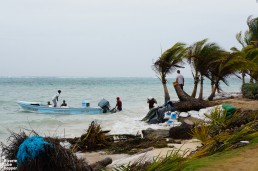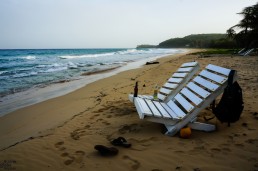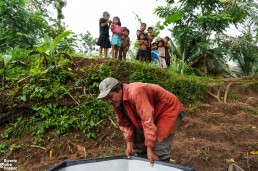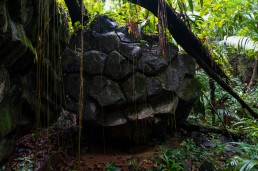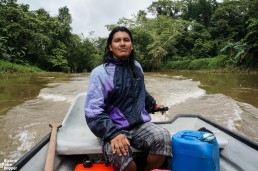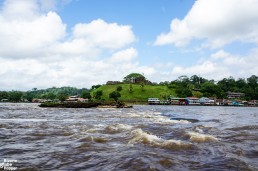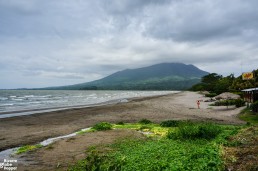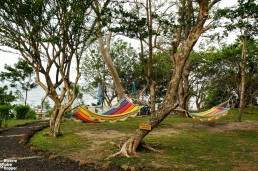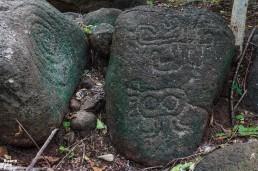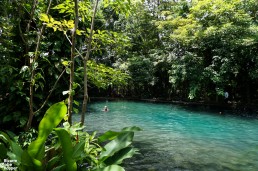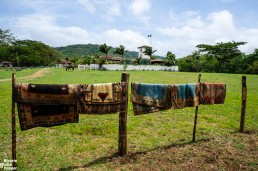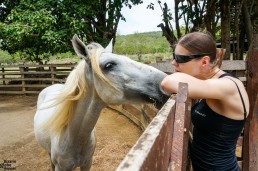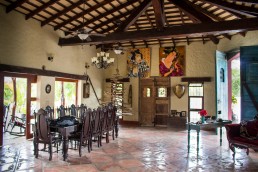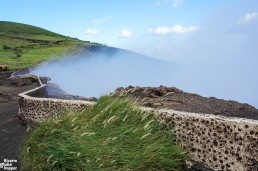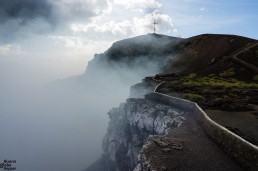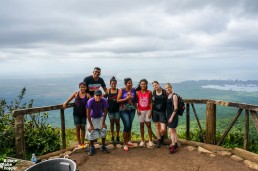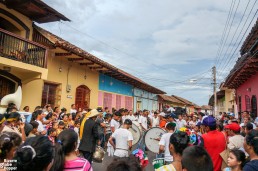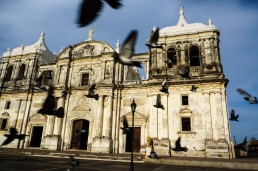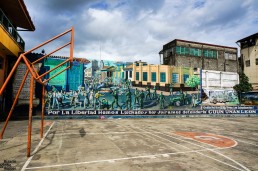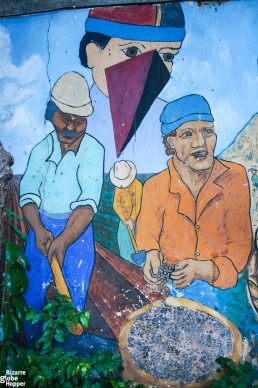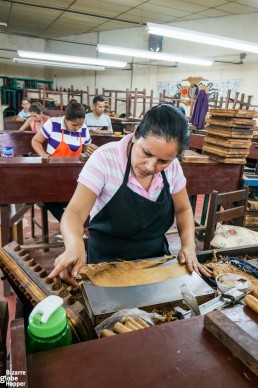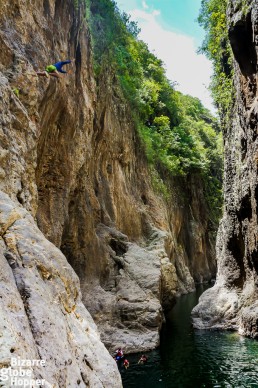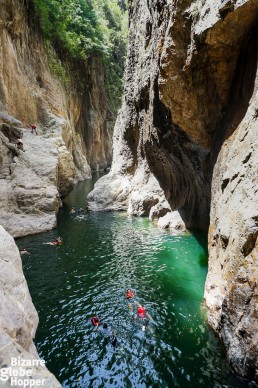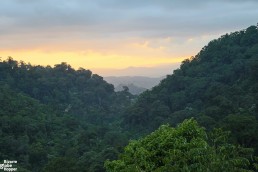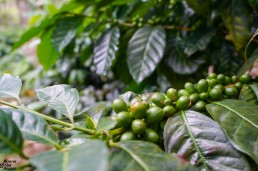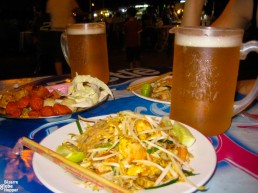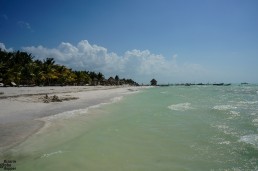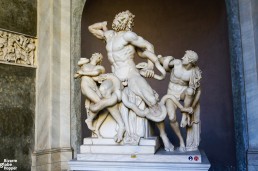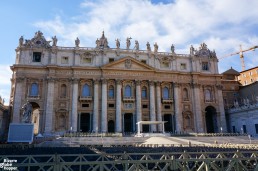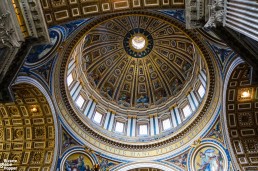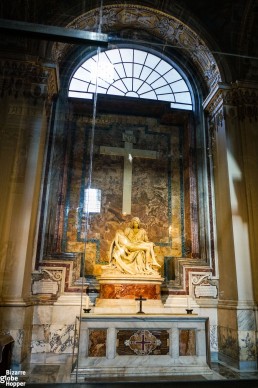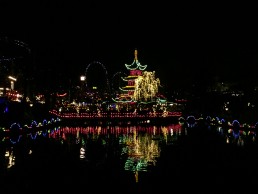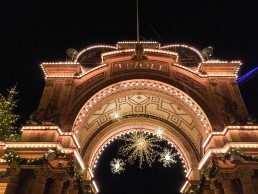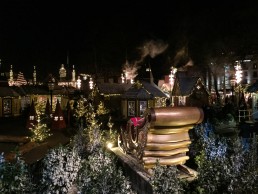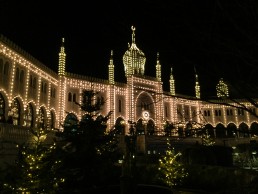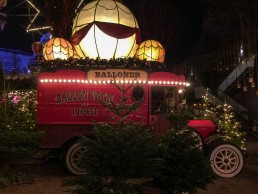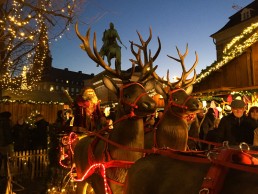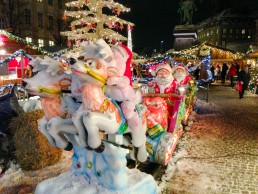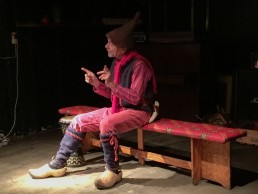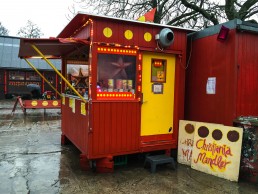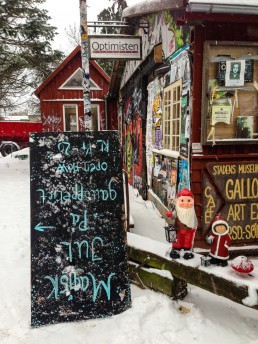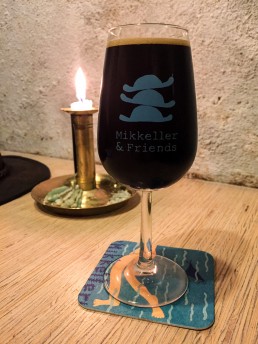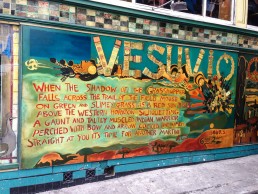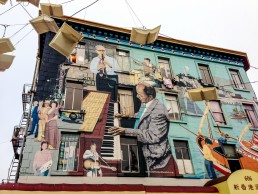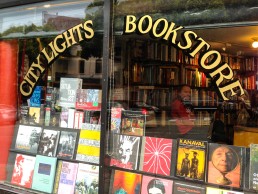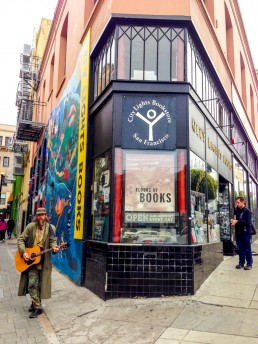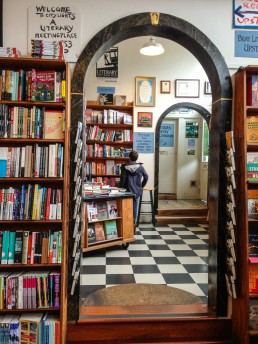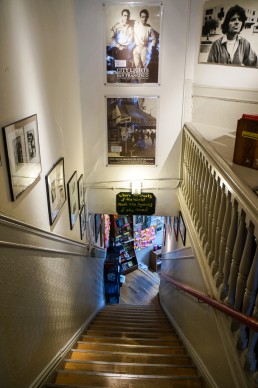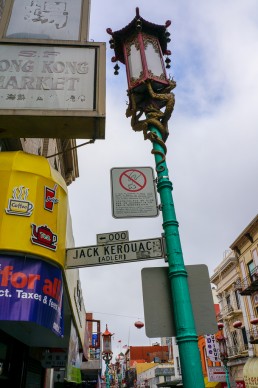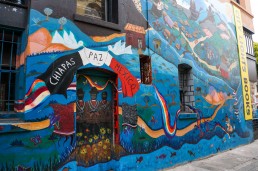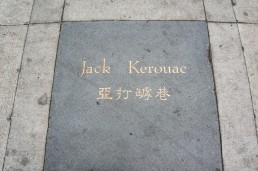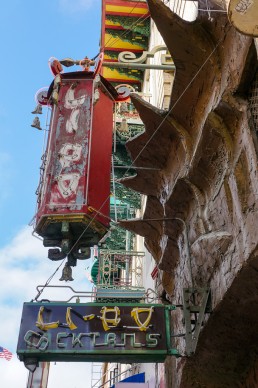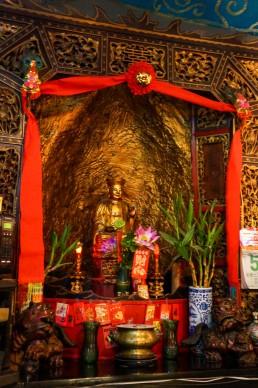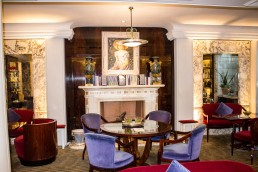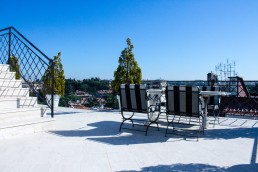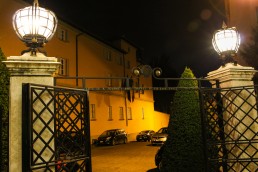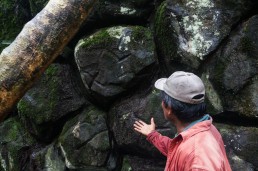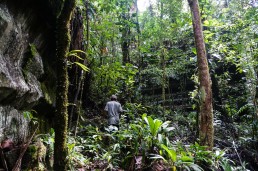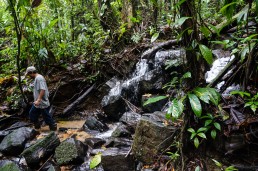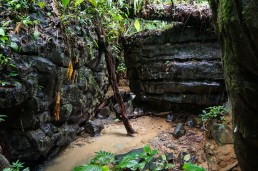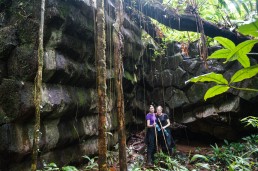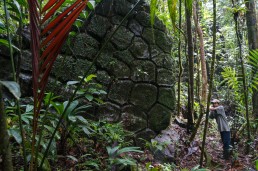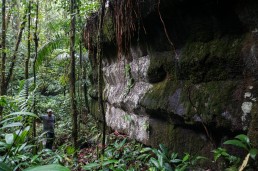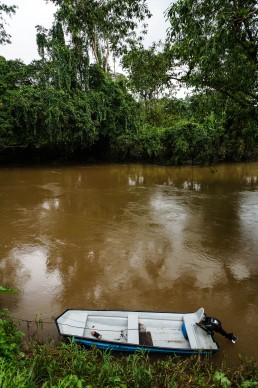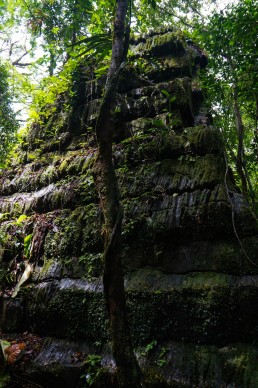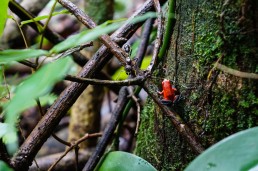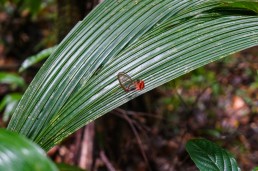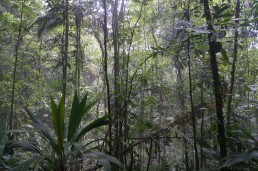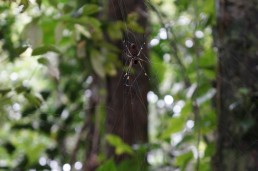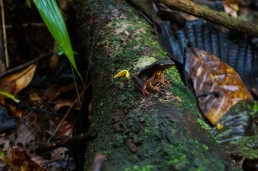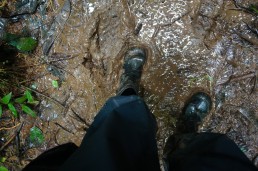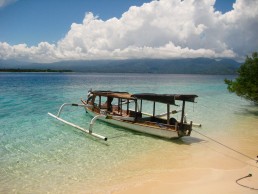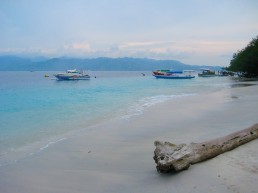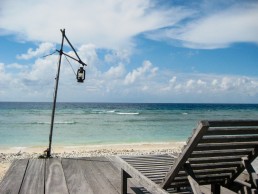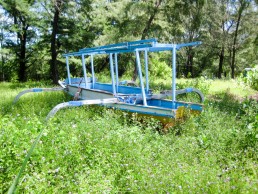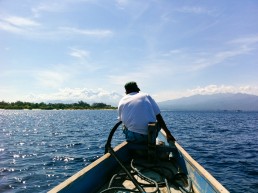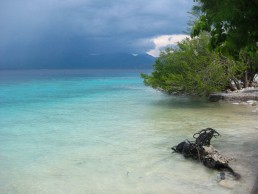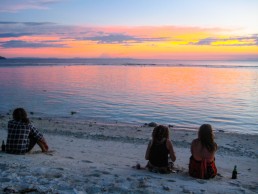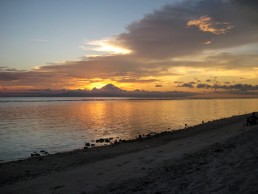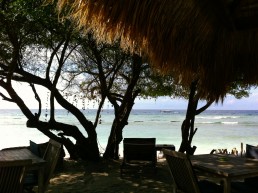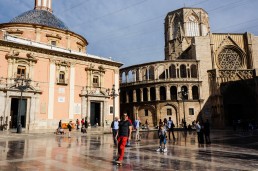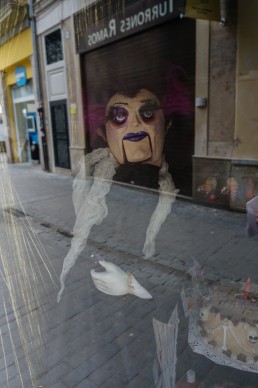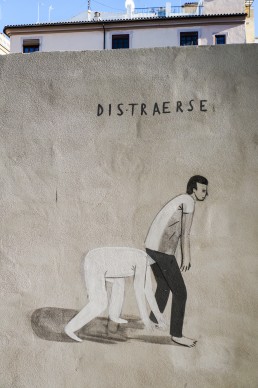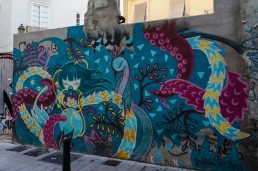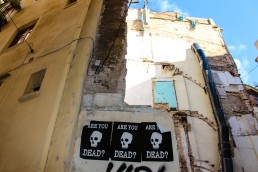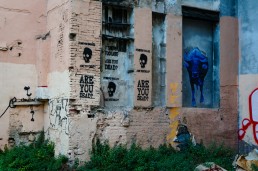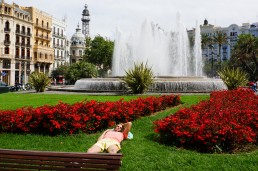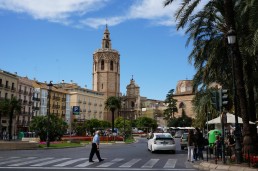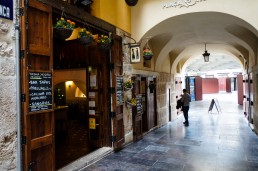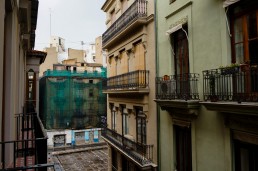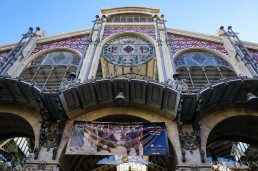Nyiragongo Volcano Trek: How to Hike to Active, Fire-Spitting Volcano in Congo DR
Nyiragongo volcano trek isn’t for everybody: grueling 5 to 8-hour hike takes you to the active lava lake, which boils like a gigantic atlas of doom, making you second guess your existence. It’s a hassle to organize visas to the DRC and permits to hike the enigmatic Mount Nyiragongo, and security situation in Virunga National Park is flickering. Weather at the Nyiragongo summit is hostile, cold, and damp; accommodation is rundown and you have to carry everything you will eat and drink. But nothing beats the magical feeling when you’re finally standing at the edge of Nyiragongo Crater, heart racing and hands shaking, staring down to the fire-spitting lava lake, which glows red in the pitch-black darkness.
This article has been completely updated in January 2019
Why We Decided to Climb Nyiragongo Volcano Despite Warnings and Growing Pains
Years ago, I stumbled upon a jaw-dropping image: a tiny tent glowing at the volcano rim, just above a viciously fire-breathing lava lake. It looked insane, but at the same time, I felt a flash of pure beauty.
The caption declared that this out-of-this-world volcano called Mount Nyiragongo lies in the Democratic Republic of Congo. It set off my alarm bells, but soon the only thing I felt was a compulsive beat banging against every cell of me: I must climb Mount Nyiragongo, although minutes ago I hadn’t known that this surreal boiling volcano even existed.
Quenching the thirst of adventure didn’t come easily. After some manic googling we found out that it really is possible to visit the Congo DR nowadays, though it’s not advisable according to most countries, such as the USA or our own. The dream was soon eluded, but not forgotten.
When roaming Uganda and Rwanda, we caught ourselves gazing dreamily over the border of Congo DR. It was so close, yet so unattainable. We decided to do everything we possibly could to cross the Congolese border and complete the crazy Nyiragongo volcano trek. Well, we eventually did cross the border, and it wasn’t too smooth, but that’s a whole another story – including bribes at the border.
Lesson learned: if you are planning Nyiragongo Volcano trek, contact Congolese travel agencies. They will organize your visas and Nyiragongo hiking permits at a very reasonable cost. Check the current security situation in Virunga National Park and Goma area before booking your Nyiragongo trek.
Virunga National Park is re-opened in 2019
Because of the various tragic incidents that have happened in Virunga in 2017-2018, Virunga National Park authorities decided to close Virunga from tourists in 2018. Luckily, Virunga National Park was re-opened in February 2019. Nyiragongo treks and gorilla treks in Virunga are operational again. Virunga National Park authorities claim that the security situation near Nyiragongo volcano has improved radically so that they can guarantee the security of Nyiragongo treks.
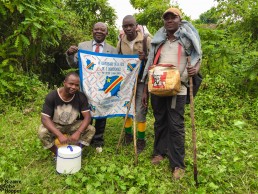
Our Nyiragongo Trekking Experience From Start to Finish
If you’re planning Nyiragongo hike, you’ll probably like to how horrible and awesome it will be. That’s why I’ll recap our experience below from start to finish, with some practical tips like how to avoid acute mountain sickness. If you’re still more interested in the practicalities, feel free to jump to the planning sections to draft your own Nyiragongo packing list.
Entering Virunga National Park and Kibati Ranger Station, the Starting Point of Mount Nyiragongo Trek
Our Mount Nyiragongo hiking day dawned finally after an exciting night and day spent in the Congolese border town Goma. Our tour operator picked us up and off we drove through the borderland of Goma, noticing how literally this town lies in the shadow of Mount Nyiragongo volcano. During the 20-kilometer ride, we saw how the recent Nyirangongo eruptions had destroyed life, but in the middle of the debris and collapsed houses there were still laughter and hope.
After a while, rusty and bullet-ridden signs welcomed us to Virunga, the oldest national park in Africa. Conveniently located at the trailhead of Nyiragongo volcano, Kibati ranger station is the starting point for all Nyiragongo volcano treks.
At Kibati, we were greeted by a group of muddy hikers returning from the summit. They seemed tired, but grinned blissfully and couldn’t stop extolling the Nyiragongo adventure, pumping our adrenaline levels even higher. After signing the papers (yes, the risk was our own), we got a short briefing from the park rangers and were finally ready for our Mount Nyiragongo trek!
The First Leg of Nyiragongo Trek: Hike Through Lush Rainforest
A pleasant rainforest accompanied us through the lower slopes of Nyiragongo. Monkeys, chimpanzees, bushbucks and even gorillas habituate these lands, but we saw only some birds and ants. The latter were my enemies – they made me jump over their paths and almost run a couple of hundred meters just to make sure that I didn’t get any unwanted travel companions.
Even though rangers hype the possibility of seeing chimpanzees and gorillas during Nyiragongo hike, those diamond sightings are reserved for separately chargeable gorilla and chimp treks. We did gorilla trekking in Uganda: if you haven’t done it before, consider adding it to your trip, as Virunga is the most affordable place to track gorillas. Check our gorilla trekking experience for inspiration!
The First Break on Nyiragongo Trek Comes After 1-1,5-Hour Hike
The first break on our Nyiragongo trek was well deserved after an hour of hard work. Armed rangers patrolled at both ends of the path while we celebrated our first triumph with some homemade Congolese cookies. We tackled the first leg of Nyiragongo volcano hike in almost 30 minutes before the usual schedule, which made our rangers proud, but ourselves a bit worried.
Whereas the Nyiragongo climb begins at 1989 meters, it ends 4-8 hours later in the whopping 3470 meters, so the ascend is quick and steep. Since deciding to hike Mount Nyiragongo, I had been anxious about the acute mountain sickness (AMS), from which I suffered in Cuzco a couple of years ago.
How to Avoid AMS on Nyiragongo Hike
The best way to prevent the AMS is to climb slowly and stay hydrated. Luckily this time both of us were unaffected. Our brisk start came with a price, though. A few members of our group started to stumble over, and some were almost at the verge of giving up their dreams of conquering Nyiragongo. Our guide, Tresor, made a great job convincing the rangers to slow down before anyone was injured. In the end, hiking a mountain is certainly not a competition!
The 2. Leg of Nyiragongo Trek: Crossing the Lava Fields of Mount Nyiragongo
Just after the first break, the scenery changed radically, as the lava fields of Nyiragongo spread before us. I was surprised that the lava below our feet was from the 2002 eruption. Somehow the rugged landscape reminded me of Finnish Lapland.
Scrambling on the lava gravel wasn’t easy and ascend was unmercifully steep. I praised our walking sticks dearly – you definitely need one to survive! Falling might be dangerous, as the volcanic gravel is ruthlessly sharp and spiky.
We had felt tired already after the first leg of our Nyiragongo trek, but the stunning views towards the neighboring volcano loaded up our energies again. Fortunately, the breaks started to pour in faster, in about 30-45 minutes intervals.
Be Prepared for Sudden Rain in the Slopes
The next affliction came out of the blue, though. Just after grabbing our sandwiches at the second break, the cloudburst began. We were hoping for just a quick shower, but torrential downpour became our companion for the next hours, making the last legs of our Nyiragongo hike even harder. During the rainy season, it’s impossible to avoid getting wet, but the dry season was almost here. We just had just bad luck.
The slope of Nyiragongo was getting even steeper, and the thinning air made us gasp. Rain blurred our vision, leaving open just ten meters around us.
Stopping By Fissures and Struggling Through Mud and Barren Lava Fields
We stopped briefly at the fissure from where the lava of Nyiragongo had burst all the way to Goma, creating massive channels. The volcano was breathing in heavy fumes through smaller fissures, reminding that it’s still alive.
Die-hard trudging in the middle of thick smog and drizzle brought us to a new rainforest, which had grown upon the lava fields from the 1977 Mt Nyiragongo eruption.
First, the loose lava surface turned into slippery mud. Then the desirable shelter was ripped off, again. We continued to struggle our way through barren lava fields. My fingers were so frozen that it started to feel like our dearest Lapland, in the arctic circle of Finland. Congo DR took us by surprise: our waterproof gear was already soaked.
The Last Legs of Nyiragongo Trek and Reaching the Volcano Summit
Torrential rains forced us to cancel one of the official breaks on the Nyiragongo hike, so the final rest stop was already above the clouds. At last, we could see the peak of Nyiragongo volcano upon us. But the climb seemed disheartening: the ascension looked like 45 degrees.
Our jovial guide Tresor raised the spirits by telling that the Nyiragongo summit was just 200 meters upon us. It was a tough struggle, though. The volcanic gravel was so loose that it brought down several members of our group.
The final leg took only half an hour. Nevertheless, it was the hardest part of our Nyiragongo hike, with already tired muscles.
The Nyiragongo volcano summit was in the clouds when we arrived. I had heard that some trekkers don’t even see the lava lake, which made me nervous. Tresor comforted me by telling that the sky usually clears up after heavy rain. Suddenly, our wet gear brought us luck!
As we changed clothes, the landscape started to brighten up, and in one hour we could see all the way to Goma! We couldn’t have hoped for a better prize after the exhausting volcano climb, yet this was just an appetizer.
How Does It Feel At Nyiragongo Summit: Slight Fumes and Breathlessness
I was pretty terrified from the moment we acquired our Congolese visas throughout the Nyiragongo trek. However, once we reached the volcano peak, I somehow calmed down.
I was waiting for heavy smells and fumes, which feel suffocating to me since I have a chronic lung disease. When we visited Masaya volcano in Nicaragua, not even healthy persons were allowed to stay at the edge of the smoking caldera more than 5 minutes.
Luckily, it’s a different deal at Mount Nyiragongo. There’s just a light smell of sulfur hanging in the air. It’s not more than you would feel near a swamp, and much less than we have encountered in the volcanic areas of Nicaragua or Iceland. Since breathing was easy even for me, a healthy person won’t feel any inconvenience. But of course, the altitude makes you breathless, also hindering the last part of the climb.
Spending the Night at Nyiragongo Volcano Summit: Tips For Watching the Lava Lake
Are you ready to face the heart of darkness, the mouth of Hell? Mount Nyiragongo has been awarded with many nicknames and overnighting above the world’s biggest lava lake is a nerve-wracking idea.
The Nyiragongo summit camp lies a bit below the highest point of Mount Nyiragongo. So when you’d like to peek at the blazing lava lake, you’d need to climb to the volcano rim with a ranger or your guide.
I suggest witnessing the lava show both at the twilight and right after the darkness has fallen because lightning affects the atmosphere drastically. During the night, the Nyiragongo lava lake is usually more visible. We were incredibly lucky because at the time of our visit the Nyiragongo crater was fully “open” like locals say, meaning that clouds and fumes didn’t cover the view at all.
The boiling lava of Nyiragongo crater lake forms beautiful, constantly changing compositions. It looks like a world map, where the countries are exploding and re-forming right under your eyes.
Gazing at the fiery lava lake after the nightfall was something I won’t ever forget, though I was shivering from both coldness and fear. Here you can read more about the Nyiragongo lava lake and our experience there!
Watching the crater lake at the rim is safe, but of course, you need to be careful not to fall. There’s a small cross memorating one Chinese trekker who lost her life here.
Crater walls have visible layers, or lava benches if you wish, from the past eruptions. If Mount Nyiragongo chooses to erupt again, the lava flow could run even 100 km/h, since the lava is exceptionally fluid. So you wouldn’t make it very far. It’s a disturbing idea, but then again, it didn’t stop us from fulfilling our dream – and I’m still ecstatic about it!
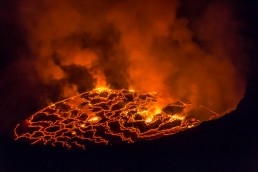
Weather and Accommodation at the Nyiragongo Summit
The inhospitable conditions at the Nyiragongo summit bring you firmly back to reality. You have to be prepared for the severe weather and very basic accommodation. The scarcely vegetated Nyiragongo summit might even be snow-capped, and the winds are harsh.
There are eight tents inside small, wooden huts, meaning accommodation capacity for just 16 people. In fact, you can’t really call them tents or cottages. There are just wooden platforms with roof and walls; most of the windows and doors are broken. Inside you’ll find a loosely hanging canvas upon two mattresses. It’s a shelter providing some shade from the harsh climate, but you definitely need to have enough warm layers to survive.
To add some challenges, both our tent and sleeping bags were wet when we arrived. Of course, also our so-called waterproof shoes were soaking and base layers all sweaty. Luckily, we managed to dry one of the sleeping bags at the campfire and used it as a shared blanket. We drank around ten cups of tea and took some soothing herbs to support sleep. I felt shivery in our tent, but finally, tiredness took over, and I managed to get a few hours’ sleep.
Toilet With a View!
The cottages at the top of Mt Nyiragongo are scattered at two narrow strips of even ground. It’s a steep trudge up and down. Thus visiting a toilet at the Nyiragongo summit is not for faint-hearted. You have to hang on tightly to the rope as you descend an extremely steep slope. Be careful not to fall as lava gravel flows under your shoes. In the outhouse, you will be rewarded with a panoramic view reaching even the lights of Goma.
Is It Safe to Climb Nyiragongo Volcano and Stay by the Lava Lake?
You can’t escape the fact that Mount Nyiragongo is one of the world’s most active volcanoes. So is it really safe to climb an active volcano? I would say yes, but the truth is that you never know. Walking around independently might be dangerous since the volcanic area has fractures emitting gas, but locals know how to avoid them.
Goma has its own seismologic observatory monitoring both Nyiragongo and its sister volcano, Nyamuragira, which is titled the most active volcano in Africa. Volcanologists should know well in advance what these giants are up to. However, due to poor funding, their resources are lacking, and the last time Nyamuragira erupted in 2010, it didn’t even give any sign.
Some volcanologists claim that during the last eruption of Nyiragongo in 2002, the fracture reached all the way to Goma. That would mean that the next time eruption might start in Goma!
Before entering the Democratic Republic of the Congo, check the current security situation. The guerrillas roam in the Virunga area since it has been the battleground for the army of DRC and different armed groups, such as the FDLR (the remnants of Rwandan Hutu rebels), for some 20 years now.
Every hiking group heading to Nyiragongo volcano will have two armed rangers. We had even three, which made us wonder if the hike was more dangerous at that time. When some tourists were left behind during the climb, our rangers seemingly panicked and couldn’t even hide their reactions. So there might be real dangers hiding in the bushes, although we felt completely safe during our Nyiragongo trek.
How to Book Nyiragongo Volcano Trek
Several Congolese tour operators can organize the Nyiragongo volcano trek, and it’s also possible to book it independently from the Virunga National Park. We would suggest picking a local tour operator listed in visitvirunga.org, the official tourism site of the Virunga National Park.
We booked our Nyiragongo trek through Kasitu Eco Tours. They were able to get our Congolese visas in a just one day instead of the officially required seven days. Our tour cost 500$ per person, including the visa (100$), the national park fee (250$), all transports, private guide, an excellent cook at the Nyiragongo summit, and all the food and drinks during the hike. Kasitu Eco Tours picked us up from Gisenyi, the border town on the Rwandan side, and helped us through the border of DRC (we wouldn’t have been able to cross the border without their help and bribing the officials).
Our guide Tresor was both enthusiastic and informative; an excellent travel companion in every sense. Whenever we stopped to take a breath, he conjured up different sweet or salty snacks. We were surprised by the quality of the food at the Nyiragongo summit: our dinner and breakfast at the mountain were so much better than most of the meals in fancy hotels of Uganda. The starter salad was actually among the best we’ve ever had in Africa. And it was cooked over a campfire at sweeping 3470 meters!
What You Need to Know Before Nyiragongo Volcano Trek
- Book your Nyiragongo hike well in advance. Only one group can hike to the Nyiragongo summit daily, and the group size is limited to 16 persons, due to the accommodation capacity. During June and July, the Nyiragongo treks can be fully booked.
- You must arrive at the Kibati ranger station before 9 AM; the Nyiragongo trek starts around 9.30-10 AM. If you’re late, you’re simply not allowed to hike and won’t get a refund from trekking permit.
- The Nyiragongo climb takes 4-8 hours depending on the weather conditions and overall fit of the group. It is possible to conquer Mt Nyiragongo also on a day trip, but it will be a long and very challenging day: we can only recommend an overnight hike. Reaching the summit can take up to 12 hours if you’re in a slow group and weather is poor.
- Porters can be hired at the Kibati ranger post for 25$, and I strongly recommend taking one to save your energies. We had one porter for two of us carrying a shared backpack and of course our waters and meals. The maximum weight for one porter is 15 kg.
- Nyiragongo trek is relatively easy but tough. That means you can hike Nyiragongo without any pre-training, even though you might not be fit. There were young and old people in our hiking group and most people made it all the way to the top. It’s more mental than physical struggle: you just need to continue even though you might feel too tired to walk, rain limits your visibility, and loose rocks are slippery.
- Take a walking stick. It’s essential to survive the uneven slopes without constantly falling down. Did I already mention that falling down might be dangerous?
- Know the risks. Check the security situation before you go.
- Avoid acute mountain sickness (AMS) by hiking slowly. The hiking group is usually divided into two: the other group climbs faster and another takes it slowly. Depending on the group, the hike could take up to 12 hours. Listen to yourself and choose your own pace. You can also prevent AMS by taking pills.
- Don’t take your drone. Nyiragongo is called a drone graveyard for a reason: flying a drone upon an active lava lake will destroy your toy.
- If possible, avoid the high season and weekends to get a smaller hiking group.
- Take only the gear that you will need. Left your heavy luggage to the storage room or to your tour operator.
- Park rangers lead the hike even if you have booked the trip through a tour company. As we booked through a travel agency, we had our own guide, porter, and cook. The cost wasn’t much higher, so we highly recommend booking through an agency. The company helps you to cross the Congolese border smoothly and you’ll get many extra perks during the hike.
- Pack enough warm layers and rent a sleeping bag: check the packing list below for other hiking essentials.
The Essential Packing List for Nyiragongo Volcano Trek
- Good, water-proof hiking boots
- Full rain gear
- Warm layers: long underwear, enough warm socks, gloves, fleece or woolen shirt, a set of clothes. When finally reaching the Nyiragongo summit, you’ll need to change a dry base layer immediately. Don’t underestimate the conditions, as the temperature at the summit might be near freezing and the risk of hypothermia is real.
- Hat and scarf
- Snacks
- Sleeping bag: Included in most packages, but if you don’t have a sleeping bag, you can rent one for 7$.
- Lots of water: staying hydrated prevents AMS. Please note that without a meal plan you need to carry loads of drinking water, as there’s no water source at Nyiragongo. If you pay for the meals, your porter carries enough water for you.
- Food: If you don’t have a cook with you, bring enough food for a filling dinner. A hot 3-course meal can really make the day after an exhausting trek. So consider hiring either a chef or cooking utensils. I’d suggest selecting the meal plan, which covers dinner, breakfast and ample snacks during the hike.
- Camera
- Dry bag for your camera and phone
- Headlamp or powerful torch makes life easier when you descend the steep slope to the toilet during the night
Final Conclusion: Is Nyiragongo Hike Worth the Price and Effort?
Despite the steep prize and rough climb, we were extremely content with our Nyiragongo trek. Not everyone in our group agreed, though. Some felt that the tough trek and conditions were too much to bear.
If you think that $500 is too high price for an overnight trek, think twice. The package price includes a visa to the DRC ($100), Nyiragongo hiking permit and Virunga national park fee ($250), all food and water during the trek (carried for you), private chef at the summit, a sleeping bag and walking stick, plentiful snacks, all transports (from Rwandan side to Goma and from Goma to Virunga National Park), and a private guide who will enrich your Nyiragongo experience (we loved our guide Tresor and still talk to him frequently).
If you are moderately fit and can handle camping at the cold temperature for one night, the unreal sceneries of Nyiragongo crater lake will bewitch you for good. The prize of Nyiragongo trek is witnessing the boiling lava lake at the top – it was one of the undisputed highlights of our one-month tour in Uganda, Rwanda, and Congo DR.
Pin this volcano adventure!

Unveiling the Bizarre Facets of Vatican
Vatican is definitely one of the most bizarre places on earth. A city-state the size of a golf course has ATMs speaking Latin, mysterious secret archives, and probably the most important art collection in the world. We entered the gates of Vatican in search of the bizarre factors – and were not disappointed.
Breaking the Art Records
Quite uniquely the whole country is labeled as a Unesco World Heritage site. Impressing 9 miles of artworks are tucked into 1400 galleries inside the Vatican Museums. If you yearn to admire each artwork for just one second, you’d need five years. So pick your route carefully, if you have only a few hours to spare.
The galleries are bubbling with intriguing stories. I’ll share just a little sample here since more are featured in a separate post. After the Pope’s Master of Ceremonies called the freshly painted Sistine Chapel a brothel, Michelangelo immortalized him as one of the figures in Hell, decorated with donkey ears and tiny genitals that remain an eternal supper for a serpent. Enraged conservative appealed to the Pope, who in turn joked that his authority didn’t extend to Hell.
The Highest Crime Rate in the World
Who would have thought that visiting Vatican might be dangerous? You probably won’t face any serious crimes, but pickpockets abound. One reason is the crazy flow of tourists. As Vatican has only one judge and no prison, most criminals are simply thrown across the border back to Italy. Although there has been only one official murder inside the walls of Vatican, rumors tell about sudden deaths of some unlucky bankers.
Cocky Secret Archives
The Vatican Secret Archives, found in 1612, were opened to scholars in 1881. Over 50 miles of shelves are known to contain for example state papers and letters. Still today solely scholars may apply for the access – as a tourist, journalist or undergrad you won’t have a chance. The second catch: you need to know exactly what to ask, since browsing the Vatican Secret Archives is not possible. Some enticing samples include letters of Michelangelo and Abraham Lincoln along with transcripts of the trials against the Knights Templar and Galileo Galilei.
And then there’s this one, particularly bizarre thing. When you’ve walked around the Vatican Museums for a while, you might notice that most of the ancient statues have been castrated. All penises censored by righteous popes through the centuries are stored in the secret archives. And this is not a legend.
Intricate Money Matters
The smallest country on earth isn’t poor. It receives 70 million euros as tax-free donations each year, in addition to its other investment earnings (like the banking and stocks profits). Vatican also mints its own versions of euros with Pope’s head although it’s not even a member of the EU. Vatican’s financial matters have regularly been in the news. Last time the economy minister told that they had accidentally found hundreds of thousands of euros tucked away in the accounts of the Holy See, which coincidentally didn’t appear in any records of the city-state.
The Vatican Bank, officially named as the “Institute for the Works of Religion”, reports to the commission of the cardinals and the Pope himself. Its history is filled with secrets, scandals, and accusations of money laundering. The Vatican Bank eludes the jurisdiction of the Holy See since the assets are not its property.
Mingling the State With the Church
The terminology might be a bit confusing. For example, the ambassadors are representing the Holy See, not the Vatican city-state. Whereas the Holy See has roots in antiquity, the Vatican state was born in 1929. The Holy See is viewed as a state, and it has Vatican as its sovereign territory. Still, the Holy See is “the ecclesiastical jurisdiction of the Catholic Church in Rome” (according to Wikipedia). The government of the Holy See is called the Roman Curia, through which the Pope governs the whole Catholic Church. Speaking of the Pope: he’s also the only absolute monarch in Europe.
All this leads to a rather complex question: is the Holy See merely a church or an independent state? For example in the UN, the Holy See enjoys the same privileges as governments, unlike any other religion. Yet it exerts its religious moral code and lacks citizenry.
World’s Biggest Basilica Lacks Paintings
St. Peter’s Basilica doesn’t have any paintings – they are substituted with mosaics to ensure the artwork will endure the annual visit of more than 7 million people. St. Peter’s Square will trick your eyes even more: if you stand in a particular spot, three of four lines of the bordering columns will disappear from your sight. Thank Bernini for the brilliant illusion!
Guards Dressed Like in the Middle Ages
Don’t laugh at the funnily clad guards outside the St. Peter’s Basilica. From the 1600th century, when Pope Julius II decided that Swiss soldiers were the most reliable and loyal, all the guards of the Vatican have been required to be both Catholic and Swiss. Guards get the citizenship at the time of recruitment and lose it with the job. Design of the clown-like uniforms dates back to early 1900s. Speaking of the style: there is a dress code to enter the country, so remember to hide the flesh! Women should cover their shoulders and men can’t wear shorts.
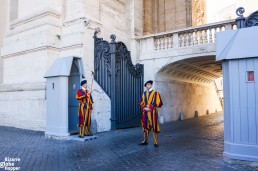
World’s Biggest Basilica Lacks Paintings
St. Peter’s Basilica doesn’t have any paintings – they are substituted with mosaics to ensure the artwork will endure the annual visit of more than 7 million people. St. Peter’s Square will trick your eyes even more: if you stand in a particular spot, three of four lines of the bordering columns will disappear from your sight. Thank Bernini for the brilliant illusion!
Guards Dressed Like in the Middle Ages
Don’t laugh at the funnily clad guards outside the St. Peter’s Basilica. From the 1600th century, when Pope Julius II decided that Swiss soldiers were the most reliable and loyal, all the guards of the Vatican have been required to be both Catholic and Swiss. Guards get the citizenship at the time of recruitment and lose it with the job. The design of the clown-like uniforms dates back to the early 1900s. Speaking of the style: there is a dress code to enter the country, so remember to hide the flesh! Women should cover their shoulders and men can’t wear shorts.
Escape Vatican Like the Popes
When you’re puzzled enough, follow an example of the bygone popes and escape outside the Vatican walls to the Castel del St. Angelo. It has almost as bizarre history as the city-state: originally Hadrianus build it as a mausoleum for himself. Later on, popes have used it as a castle and a prison. When things heated up, popes used to escape through a secret passage connecting the St. Peter’s and the Castel del St. Angelo. For example, during the sacking of Rome, the passage saved the pope of the moment, Clement VII when almost all of his Swiss Guards were executed at St. Peter’s. As a curiosity, he still ended up imprisoned in the Castel del St. Angelo for six months.
From a scale of 1 to 10, how weird you hold up this walled enclave? Have you heard any strange stories about Vatican? Feel free to share them with us, the more bizarre – the better!
Pin this story!
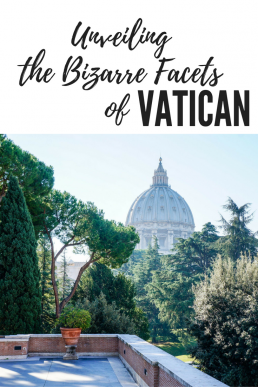
Best Things To Do in Cartagena, Spain: From Quirky Sights to Roman Ruins and the Best View
Fill your day trip to Spanish Cartagena with exciting things to do and see: from quirky Roman ruins to shopping and pleasant walks under the ornamental balconies. Find the best views in Cartagena, explore the port area, and breath in the Spanish atmosphere over coffee or drinks.
Explore the History of Cartagena, Spain
Join me as strip the history of Spanish port town Cartagena on a short day trip. This multilayered city has seen Roman, Carthaginian, and Arabic rulers during the last 2200 years. In just one day you can dance with the dead in a medieval funeral crypt, feel the glory of the Roman Empire at several archeological sites, and crown the day with a sweeping view over the city from a colonial-era castle.
Cartagena’s vibrant past absorbs through your skin even on a short walk along the narrow streets. The old town of Cartagena is guarded by five hills just like in Rome. Ancient ruins are well presented in several intriguing museums, but glass-covered excavations dot the streetscape, too. It pays to look up constantly – I couldn’t stop photographing the plentiful ornamental balconies. Baroque, neo-classical and Art Nouveau architecture give Cartagena an extremely photogenic flair.
The old town is compact and easily navigated. The sights mentioned here are very close to each other. Walking is the most enjoyable way of experiencing the city, although bikes are also available.
Dance With the Dead in a Funeral Crypt
If you are on a daytrip in Cartagena and arrive with either train or bus, a museum called Centro de Interpretacion Muralla Punica makes the most logical first stop. Calle San Diego begins at the roundabout near the train and bus stations. Just follow it for a few hundred meters and you’ll see the museum on the right side. Downstairs you’ll find a chamber, which is believed to be the burial place of the Guild of St. Joseph. The crypt is well preserved and atmospheric, though small. “Dance with the dead” was the leading theme in murals, and the faded remains of skeletons still entertain scarce visitors. You will also be rewarded with some weary skulls and bones.
As an added bonus you can also visit the main sight here: the Muralla Punica ie. the Punic Wall. This Carthaginian wall was built in 227 BC with the foundation of the city, so it brings you to the very beginning of the storyline. The conserved stretch once marked the entrance of the city.
Most tourists seemed to visit only the wall, so be sure to make the detour to the crypt! Even after seeing the catacombs of Rome this funeral crypt felt a spectacular experience. Photographing is allowed and you are quite likely visiting the site alone, which are both rare treats in similar places in Rome.
Walk Around a Roman House, Casa de la Fortuna
Continue the same street, Calle San Diego, just a few hundred meters from the Punic Wall, until you reach Casa de la Fortuna – the House of Fortune. The adorable little museum is located inside a Roman House dating back to the 1st century BC.
This house, over 200 m2 wide, belonged originally to a wealthy merchant family. You can walk through the ruins of the house, seeing kitchen and dining room with an attached shop area, relatively small bedroom, and a vast atrium and representation rooms. At the rear end lays an entrance and a conservated stretch of the ancient road. Casa de la Fortuna is among the most enjoyable little museums I’ve visited. In a dimly lit, relatively tourist-free museum you can really imagine how the original Roman house around you has once looked.
To get to the next destination, the Roman Theatre, stroll through the old city and stop to have a refreshing café solo at San Francisco square. Then continue towards Plaza del Ayuntamiento through the main shopping street Calle Major.
Visit a Reconstructed Roman Theatre
Discovered in 1988 and rebuilt until 2003, the Roman Theatre is clearly the blockbuster sight of Cartagena. The site served as a theatre from 1st century BC to 3rd century AD until a market was constructed upon it in a very Roman way, using the old theatre as building material. In the 13th century the same grounds hosted a cathedral.
Entrance to the Museo del Teatro Romano is from the bustling Plaza del Ayuntamiento, just opposite the town hall. You have to walk through a multistoried museum to get into the theatre itself. A nice stroll among ancient statues, and through corridors and a crypt of the medieval cathedral transports you gently into the ancient times. It is allowed to climb the steps to the top of the cavea and you can test your acting skills at the stage as well.
Stroll Through the Port of Cartagena
Get some fresh air and wander towards the medieval castle along the seaside promenade, admiring swanky yachts and huge cruise ships. Throughout the history Cartagena has been one of the most important ports in the western Mediterranean. Phoenician traders docked here well before the city was founded by the Carthaginians in 227BC. During the Roman Empire this port town flourished under the name Carthago Nova. While Muslims expanded their kingdom to Spain in the 700s, once again Cartagena was in a major role due to its strategically located port.
Some of the boats are turned into restaurants and make a fun pitch stop. You can see the next destination, Castillo de la Conceptión, above the bay, watching over the city.
Take a Panoramic Lift to the Colonial Castle
Modern glass elevator lifts you 45 meters above the city, from where it’s a short hike to the colonial castle with 360-degree view over the city. The castle was built using the materials from the ancient amphitheater. At the time of my visit there were two small exhibitions, one about Leonardo da Vinci and another about the history of Cartagena. At the halfway the panoramic lift stops also at the Civil War Shelter Museum, which I didn’t have time to explore.
I don’t usually roam the museums during just short daytrips, but the museums of Cartagena were really fun to visit. Visiting all the four museums, walking through the port, and sipping one perfect café solo in the San Francisco square took really just 5 hours. Of course touring the city would be even more enjoyable, if you have more time to spare. I still plan to return some day just to linger over one or two nights. Cartagena really deserves an overnight visit, although you can pack much into a well-planned daytrip as well.
If you are visiting several museums in Cartagena, consider buying a “museum pass” consisting of four, five or six entrances (12/15/18 €). Passes are available at all sites. Just compare the prices before buying the pass, as the entrances to for example to Casa de la Fortuna and Muralla Punica/Funeral Crypt are really cheap (3,5/2,5 €).
Pin this story!
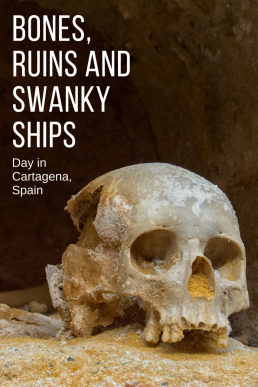
How to Plan the Best Safari in Tanzania
Before even starting to plan a safari in Tanzania, ask yourself a few crucial questions. What kind of experience are you looking for: budget or luxury safari, or perhaps something in-between? When are you willing to go? How many national parks you’d like to visit? Identifying your own needs is the first step of careful safari planning. After that, you can either contact safari companies or start sketching the itinerary on your own.
Why Independent Safari is Not the Best Idea
Most people book their safari through a safari company, as it’s by far the easiest option. We are independent travelers, but because of all the hassle we didn’t even think about organizing a safari ourselves. There’s so much paperwork with the park entrances alone that I suggest you’ll leave it to professionals – even they seem to struggle with an administration at times. Lodges inside the national parks need to be pre-booked and trusted safari companies get the best deals. You really need a guide who knows how to track wildlife and driving around the dirt roads ain’t easy. In the end, what’s the point of the safari if not maximizing your chances to see wildlife?
Tweak the Price With Your Choices
The biggest factors affecting the price tag are group size and accommodation level. Do you insist on having a top-end private safari or are you happy with staying in tents and sharing the jeep with others? Accommodation choices run basically from bush tents through tented lodges to luxury lodges and private tented camps.
We usually prefer unique boutique hotels, and thus ended up mixing some unique tented lodges with luxury lodges. The combination was the best we could have thought of since tented lodges gave us more profound insight into our surroundings, but we had still all the modern digs like a hot shower, comfy beds, and 24/7 electricity.
Pros and Cons of High and Low Season
Timing affects the price tag as well as the itinerary. If you’d like to see the great migration, it’s practically possible in Tanzania around the year, but might require longer legs during the wet season. In general, dry season (from June to August) makes wildlife spotting easier, as animals congregate around water sources. That said, the low season brings discounted prices to accommodation as well as safari tours. Harsh rain is seldom fun, but the shoulder of the rain season might be the best time for a safari in Tanzania. Famous parks, such as Serengeti and especially Ngorongoro, get extremely crowded during the peak season. It might turn off your wilderness fantasies to share each animal sighting with tens of jeeps.
Visiting Tanzania during the wet season requires more careful itinerary planning, thus experienced safari company becomes your valued friend. Some parks, like Lake Manyara, run down of animals after the great migration has passed, and water is no longer available, so it makes no sense to do game drives there. On the positive side, landscapes are lush, and tourists are few. It rarely rains the whole day. Low season in Tanzania starts in March and ends in May. Our safari took place in March, and during the two weeks’ time, it rained only once at night. You really cannot predict nature.
Tailored or Fixed Safari Itinerary?
Some companies offer fixed safari itineraries at more or less fixed prices, usually for fixed sized groups. If the suggested route fits into your likings, it’s not necessarily a bad option. Just bear in mind that these itineraries usually tour the beaten path. Then again, if you have limited time, you might want to visit the usual highlights like the most visited parks. Pre-packaged private safari might be a cheaper option as well, as the safari company can negotiate the best deals with the hotels they frequent.
It’s still recommendable to ask, if the safari company can adjust the itinerary according to your preferences, or if they can tailor the itinerary from the scratch. That usually tells something about the company as well. Check out also our other tips on how to choose a safari company in Tanzania.
And if you want to visit a masai village, do yourself a favor and check our tips and experiences first.
What Makes the Best Safari Itinerary?
If you are visiting Tanzania for the first time and have more than one week to spare, it would be criminal to leave out the super stars, such as the national parks of Serengeti and Ngorongoro. I would suggest adding also some off-the-beaten path parks like Tarangire, and some more unusual experiences, like visiting a coffee farm or a mountain village that doesn’t see other tourists. But once again, it comes down to your personal preferences.
Pay attention to the transfer times and the amount of game drives in the parks. Ask your safari company if the transfer times are realistic, or can 3 hours’ drive expand to 5-6 hours due to muddy roads full of potholes. If so, are you comfortable with it? It was quite usual for us to wake around 5.30AM, have a quick breakfast and take a morning game drive, then drive straight to another park and have a lunch box somewhere on the way. After an afternoon game drive we finally checked in to a new hotel around 7PM. That makes a really long day out in the bush, but we loved every second of it. Just think through beforehand what you can handle. More game drives means also a pricier safari, as park entrance fees are steep.
In the end, planning the best safari experience depends on your personal preferences. Each safari is different, no matter how “fixed” the itinerary might be. Having a reliable safari company as your trusted guardian will guarantee that you’ll get the best out of your trip, no matter what Africa has in store for you. Take some time to plan the itinerary and choose your safari operator wisely. It will lift your safari into “the trip of a lifetime” category.
Have you been on a safari? Did you plan your safari itinerary independently or with a little help from a safari company? How was the outcome? Share your experiences with us!
Pin this story!
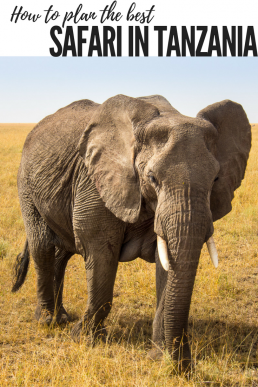
*Disclaimer: We were hosted by Ombeni African Safaris/Ombeni Foundation on a 10-day safari in Tanzania, but all the opinions and views presented here are entirely our own.
The Carved Zanzibar Doors in Stone Town, Tanzania
Elaborately carved Zanzibar doors manifest the cultural roots of the Swahili coast in Eastern Africa. The clash of Swahili, Arab, and Indian traditions is probably most notable in the design of Zanzibar doors. If you look close enough, these giant teak masterpieces tell stories of the residents’ social status, religion, and profession.
Photograph Zanzibar Doors – And Capture the Spirit of Stone Town
Zanzibar’s Stone Town is a real treat for a photographer, but especially for all the door lovers out there. Stone Town should be marketed as Instagram addict’s paradise destination, as pastel-colored wooden doors make just a perfect background for rustic urban scenes.
Cats are stretching out and chasing each other in the doorways; men are gathering at street corners to sip coffee while caught in loud debates or sitting outside their houses playing bao inertly. Kids are running after a ragged soccer ball, and women are returning home from the market carrying heavy packages upon their heads. Those distinctive Zanzibar doors are framing all these moments. Time stands still in Stone Town: It’s like a window to the past.
Where Can You Find Zanzibar Doors?
In Stone Town, the task is easy: you cannot avoid seeing tens of magnificent Zanzibar doors when walking on the main roads and maze of alleyways. You don’t need a map to find the most famous Indian, Arab, or Swahili doors: Just walk around aimlessly for a couple of hours, and you will stumble upon them. If you decide to take a guided city tour inside Stone Town, your guide will point out Zanzibar doors, as well.
One of the Zanzibar’s oldest doors decorates the entrance of Stone Town’s Old Fort. While you take highly recommend evening walk at Forodhani Gardens sampling street food, look for a stunning door at Old Customs house.
The term “Zanzibar doors” is used as a concept referring to the beautifully carved wooden doors all around the Swahili coast. Thus, you will find Zanzibar doors also for example on Lamu Island and Mombasa in Kenya. The design of Zanzibar doors has been copied all over the world, so it’s possible to find fine examples of these carved wooden doors also elsewhere.
How to Identify Swahili, Indian and Arab Doors in Zanzibar
After wandering for a few hours around Stone Town, you’ve probably walked past hundreds of brass-studded doors, and some friendly local has already told you the differences between Swahili, Indian, and Arabic door design.
Doors belonging to the same tradition can be found in groups since Stone Town has been divided into ethnic districts. Let’s take a look at the different door designs found in Stone Town, Zanzibar.
Indian Doors: Brass Studs and Carved Decorations
Traditional Indian doors, also called Gurajati doors, are usually divided into smaller sections and have foldable shutters. These wooden doors were common at bazaar streets of Zanzibar.
Another type of Indian door has heavy brass studs and arched top frame, just like in Indian palaces. Brass studs come from India, where they were used to protect the doors against elephants.
In Zanzibar, doors are embellished with brass studs purely for aesthetic purposes, as there haven’t been elephants in Zanzibar. Brass studs, just like carved decorations, showcase the wealth of the resident.
Omani Arab Doors: Carved Frames and Friezes With Inscriptions
Arab doors are generally rectangular and have intricately carved frames. They are likely to a carved frieze with Arabic inscriptions or symbols, commonly citations from the Quran. The frieze is usually carved in rosettes and might also have the resident’s name.
The oldest Arab doors have rectangular friezes, whereas newer Indian-influenced Arab doors have round friezes.
In Zanzibar, also Arab doors might have brass studs – another influence from the Indian doors. The more complex carvings, the wealthier the resident.
Swahili Doors: Simple Wooden Carvings
When compared to Indian and Arab doors, Swahili doors are more modest wooden doors without fancy decorations. Still, Swahili doors are the best and most elaborate example of Swahili architecture. Even Swahili doors have intriguing carvings.
The Swahili doors are rectangular like Arab doors, but, of course, lack Arabic inscriptions.
The oldest samples of Zanzibar doors are Swahili doors. Arab and Indian styled door designs got more popular during the 19th century.
Other Distinctive Features of Zanzibar Doors
Zanzibar doors are massive; thus many of them have smaller openings inside of them. That allows visitors to pass without opening the whole massive teak door. In the past, opening the huge door meant taking a risk that also enemies could enter the building.
Zanzibar doors have a common design. The doorway consists of a lintel, center post and two separate doors at both sides. In history, the doorway was said to have female and male doors.
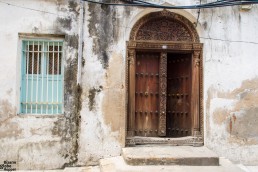
What We Can Learn From the Carved Doors of Zanzibar?
When plunging deeper into the fascinating world of Zanzibar doors, you’ll discover that each door is preciously different. Ornaments and patterns tell the story of the resident.
Wave-like patterns and ropes allude to seaborne trade. Chains are said to protect the building from evil spirits, but they also mark the mansions of wealthy Arab slave traders. Flowers at the top of the door tell how many families used to live inside, whereas vines refer to the spice trade. Geometric shapes, like squares, refer to accountants.
History of Zanzibar Doors: From Burmese Teak to Mahogany and Black Wood
The oldest Indian-inspired doors in Stone Town are made from Burmese teak, imported all the way across the Indian Ocean. After Burmese teak was no longer available, the East African teak was used instead until it was getting hard to find as well. Nowadays Zanzibar doors are made mainly from mahogany and black wood.
In the 1980s Stone Town was calculated to have 800 historical Zanzibar doors. Unfortunately, the number has decreased due to lack of renovation and eager international collectors. When we visited Stone Town, many doorways were under renovation process: We hope that renovations continue and this rich architectural tradition will be preserved.
Do you share our love of photographing doors? We’d love to know if you know destinations like Zanzibar’s Stone Town for door hunters!
Pin These Beautiful Doors!
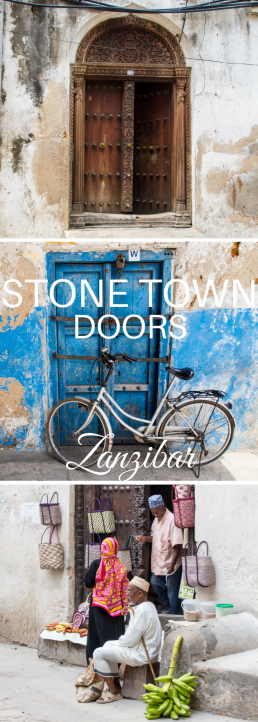
How to Choose a Safari Company in Tanzania: A Comprehensive Checklist
Choosing a reliable safari company allows you to get the best out of the gorgeous national parks of Tanzania. Safari should fall into the trip of a lifetime category, but it can also go wrong in various ways. Stay on the safe side and browse our checklist for choosing a safari company in Tanzania.
There are hundreds of safari companies in the city of Arusha alone, which is the main safari hub in Tanzania. Many will promise you the moon, but not all can deliver. To make things even more complicated, it’s not even enough to do the normal background checking since there are some specific questions that you should address.
1. Compare the Price-Quality Ratio
Prices between Tanzanian safari companies might have astronomical differences, even on the same itinerary. The cheapest option won’t probably be the best, but not necessarily the most expensive either. Of course, some safari companies just take bigger profits than others, but it pays to look at what you are really getting for the quoted price. Comparing prices won’t give you the big picture, as you should concentrate on the price-quality ratio instead.
When you’ve found a reliable safari company and told them your requirements, they usually suggest an itinerary tailored to your needs. Ask for a detailed itinerary, where you can see the actual times spent on the game drives and transfers between locations. Ask if the selected lodges are inside the national parks, as this means that you’ll be on the game drive before others even get into the park. Some lodges are located one or two hours’ drive from the gates meaning considerably lower prices, but very early morning calls and possibly fewer game sightings. Check also the reviews and the price level of the lodges from online resources, such as TripAdvisor.
Check out what is really included in the price. Some safari companies can offer two game drives in a park on a daily basis, while others offer only few game drives during the whole safari. Park fees are steep, and gasoline is expensive, so these factors affect the price tag. Is the accommodation at half-board or full-board basis? Are every excursion and activity listed in the itinerary really included, like the visiting fee of the Maasai villages (50 $ per group), hot balloon ride in Serengeti (499 $ per person), walking safari fees, etc?
I would also appreciate the membership of Flying Doctors. In the case of emergency, Flying Doctors will pick you up even from the remote areas and transport you quickly to a location with good medical facilities, where your own travel insurance kicks in. If the safari company is a member, this service comes free of charge.
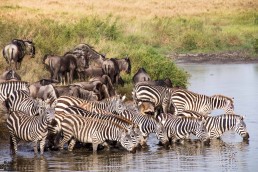
2. Look at the Setting And Resources of the Safari Company
Everyone knows that private safari is the real treat, but it comes with a hefty price. However, group size really matters on a safari. Small group safari in Tanzania can deliver way better than general group safari in terms of comfort and wildlife watching. Remember also that if you take part in a group safari, you have to go with the group’s interests and follow the fixed itinerary at all times.
Be sure to ask the number of people on the safari. Ask also how many persons there are in the vehicle and what kind of car it is. If you’d like to enjoy wildlife watching, don’t accept anything else than 4×4 Land Rover with a pop-up safari roof. Choosing a Land Rover also guarantees that you’ll have a window seat all the time. We had a 7-seat Land Rover for just three of us, which meant we didn’t have to compete for views with each another – or strangers. Smaller 5-seat Land Rover would have been enough for us, but having plenty of space made all the difference. We could move around comfortably and take advantage of every possible angle when photographing wildlife.
As you’ll be spending half of your days in the car, the comfort level really matters. Ask if the car has air-conditioning. Our Land Rover was equipped with the newest technology so we could charge our phones and cameras on the road. We also had a fridge always full of cold water and beer, which were included in the price, as well as some excellent South-African wines. It was a nice add to sip a cold beer while observing a lion family having their feast in the middle of Serengeti. Note that if you’d like to consume alcohol while in the car, your safari company and driver must have a special license to “bartend”. Fridge, instead of a cooler, also guarantees that your lunch boxes will stay edible in the heat of the day.
Ask also does the safari company own its jeeps or are they rented, and how old they are. Some safari companies are trying to rent as cheap cars as possible, which is not a right formula for you. An own fleet is usually maintained better. Last but not least, the car must be an official and registered safari vehicle.
Your guide’s skills in navigating in the parks and spotting wildlife are maybe the most important factor in the whole safari experience. Ask how the guides are trained. It’s definitely a good sign if they’ve been graduated from Mweka Wildlife College, as it’s the oldest and most appreciated wildlife college in Africa. Check online reviews of the safari company and their guides and also ask from previous customers whether they’ve been content with the guides.
If you are interested in hiking or night safaris, ask if the safari company is licensed for them. It is not allowed to walk in the main national parks of Tanzania without a license (you have to pay separately for the ranger to accompany you).
Especially if you are visiting the national parks of Tanzania during the low season, the wildlife herds might be far out, which means it takes time and gasoline to reach them. Make sure that your safari company is willing to drive as far as needed to find the great migration.
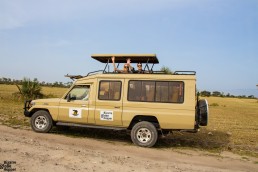
3. Draw on Local Knowledge
It’s economically sad that almost 60% of the safari companies operating in Tanzania are not locally owned. We like to support local companies, as it usually ensures that our money profits the visited country.
From what we’ve heard, foreigners might have difficulties in finding good resources in Tanzania, but at the same time they might be better affiliated with other foreigners, where in turn local operators might have their trouble. Locally owned company might understand better the roots, wildlife, and indigenous people. Local companies can also cut down middlemen meaning lower cost of operation. Then again, these are of course generalizations. Local and international ownership both have their pros and cons, and both kind of companies can be professionally hold.
If you choose US based (or other foreign) company, make sure that they really know the destination. Ask them straight questions: how many times have they been in Africa and when was the last time? Which local operators they use, and how do they control the quality? Do they hire locals, and how their guides are trained?
Tanzanian government mandates only Tanzanian registered vehicles and licensed drivers meaning that overseas companies have to use local subcontractors. Some companies don’t even tell customers beforehand that the ground operator is not the same company through which they’ve booked, so be sure to ask. Personally, I would prefer choosing the local company that I’m traveling with by myself, in other words I would book my safari through a local company or at least ask the name of the ground operator and check their background as well.
4. Double-check the Safari Company’s Reputation
As there is big money circling Tanzanian safaris, it’s a tempting trade for frauds as well. Always remember that there’s a risk when sending money to the safari company and double-check their reputation before any transactions.
Firstly make sure that the safari company is recognizable by the Tanzanian government. You might even face problems with your travel insurance if the tour operator is not registered. Registration also protects your money against disasters, as either your safari company or the government will reimburse back for example in the case of bankruptcy. You could also look for the memberships of safari associations. These memberships don’t necessarily guarantee the reputation, but the lack of them could indicate something. A reliable safari company should have an address in Tanzania as well as stable ownership. Answering actively and profoundly to your questions gives proof of their level of customer service, which might guarantee the best possible experiences on a safari.
We usually use TripAdvisor while comparing hotels and tours. It’s a fairly good tool for checking the background of Tanzanian safari companies, as well. Just bare in mind that new, small and middle size tour operators might not have as many reviews as bigger and older companies, but it doesn’t necessarily make them less suitable for you. A smaller company might be more affordable and flexible option for your safari through Tanzania. Browse enough reviews online to check others’ experiences.
Lastly, ask for several contactable references – just to be sure. If the safari company denies giving you any contacts, that’s a bad sign anyway. Ask also about their payment, cancellation and refund policies.
5. Give back!
Many safari companies in Tanzania have recently acknowledged tourists’ need to give back. Nowadays quite many safari companies state that they are involved in humanitarian work, which still might not be the case. Ask them to specify what they have done already and what kind of on-going projects they have, if you want to be sure. Some donate a certain percent of your payment or their revenue to charity; others just keep their projects vaguely separate.
If it’s possible to find objective information on how the safari company treats their workers, I appreciate it. Choosing a company with ethical operating principles is the easiest way to give back.
Our Choice: Ombeni African Safaris / Ombeni Foundation
We browsed through the list above while evaluating the best safari companies in Tanzania. After a lot of background checking and long Skype conversations, we chose Ombeni African Safaris/Ombeni Foundation. I’ll highlight here just a few things, which separated them from the other Tanzanian safari companies in our eyes.
The owner, Ben Pallangyo, is local like all of his ground team. Ombeni African Safaris supports the families of their workers, having built houses and set up funds for education. Everyone at Ombeni seemed to have a unique relationship with African nature and the sites we visited, but of course, you can experience the same with other knowledgeable local guides.
All the guides of Ombeni Safaris have graduated from the widely respected Mweka Wildlife College. After a 4-year degree, they are further trained at Ombeni African Safaris for a whole year so that eventually they’d know every possible route inside the national parks and can meet every possible need of the western tourists. Ombeni African Safaris trains guides for free and provides them also a unique opportunity to visit the US so that they would see where the majority of their customers come from. Unlike most of the safari companies, Ombeni African Safaris also uses women drivers and guides, which we admire. Equal safari companies are still pretty rare in Tanzania.
Ombeni Safaris can take you off the beaten path and tailor the route from scratch according to your likings. Even if you’d like a fixed itinerary covering the main national parks, they don’t put you on a group tour, as they don’t mix strangers in the same car – unless you’d prefer so.
The best part is that 60% of their revenue goes to humanitarian work. Ombeni Foundation supports 645 school kids in the village of Meru. Currently, they are also building an orphanage and helping pregnant women through a local clinic.
All in all, we were more than happy with our choice, since our safari in Tanzania was one of the most amazing trips we’ve ever done. Have you been on a safari or are you planning for one? What kind of things you would prioritize while choosing a safari company in Tanzania? In your opinion, what would make the best safari in Tanzania?
Pin this story!
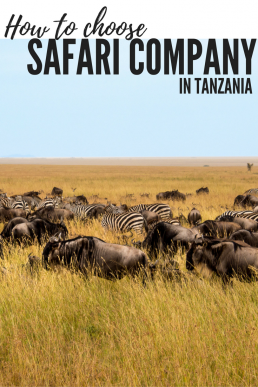
The Ultimate Guide to Mafia Island, Tanzania: What to See and Do, Where to Stay and Costs
Welcome to Mafia Island, Tanzania! Here, time stands still, the turquoise Indian Ocean offers the best diving and snorkeling in Eastern Africa, and palm-fringed beaches remain deserted. Mafia is a well-kept secret, a classic paradise island, where very few tourists are lucky to experience the life on the Swahili Coast like it used to be hundreds of years ago. Still, Mafia Island offers unique boutique hotels, diving and snorkeling tours, delicious food and tropical cocktails fulfilling the promises of a relaxing island getaway after East African safari. Read on to catch the best things to do and see in Mafia Archipelago together with further tips for finding the best hotel and tours to match your preferences!
This article has been thoroughly updated in April 2019
What to Expect From a Beach Holiday in Mafia Island, Tanzania
Mafia Island offers pure relaxation, incredible biodiversity, and world-class diving and snorkeling. Clear waters of the Indian Ocean reveal an unparalleled marine life, yet for some reason, tiny Mafia Island remains blissfully isolated from the crowds. The paradise comes spiced with an intriguing history and framed by coconut-fringed beaches.
You should like beaches, water activities, and relaxing island getaways if you visit Mafia Island: At least one of them should the reason for coming here, otherwise search for other destinations. That said, there are also many exciting things to do in the inland of Mafia, which compliment your beach holiday.
What to Know Before Visiting Mafia Island
Simple life throws tourists back to the old days in the Swahili Coast. The pace of life is slow. The main source of income is still fishing, combined with agriculture and weaving. The positives: You don’t need shoes or a watch. The negatives: There are no big resorts with fancy luxury suites nor shopping options.
Mafia is remote, sleepy and tranquil. Don’t expect any nightlife, craft beer pubs, or fancy cocktail bars. Most tourists stay at their hotels for dinners and cocktails. An all-inclusive boutique hotel is a wise choice, as there aren’t many services around.
The population of Mafia archipelago is mostly Islamic with some Christians. Tourists should dress modestly outside hotel areas, women preferably covering their knees and shoulders.
THE BEST THINGS TO DO IN MAFIA ISLAND, TANZANIA
The seductively laid-back Mafia Island has it all: On top of the underwater wonderland, there are lush rice patties and large coconut groves, stunning baobabs and mangroves, weird flying foxes and legendary dwarf hippos.
Mafia’s neighboring islands Chole, Juani, and Jibondo are really a separate story – and would each deserve at least a day tour. Both Juani and Chole have vegetation covered ancient ruins, Jibondo at its turn is famous through East Africa for traditional shipbuilding. These sparsely populated tropical islands serve as a perfect hideaway from modern civilization.
Check out the best things to do in Mafia Island, Tanzania!
1. Go Snorkeling or Diving in Mafia Island Marine Park
Snorkeling and diving are deservingly the best things to do in Mafia Island, as most tourists come here to explore the world-famous underwater world.
There’s something primal about plunging into the middle of the clouds of colorful fish and floating above giant corals. I absolutely adore snorkeling, and in Mafia Island Marine Park the experience was better than anywhere else we’ve been before. After the most unbelievable safari experience, it felt that we were suddenly swimming amidst an underwater migration. Check here our tips for snorkeling in Chole Bay, Mafia Island Marine Park.
Chole Bay snorkeling trips cost only $20: It’s a real bargain for what you get!
Diving prices start at $40 for shore dive and $50 for single dive and Discover Scuba Diving package for $110. We went with Big Blu Mafia Island Diving Center: Check out their website and further pricing here.
2. See Whale Sharks Passing Mafia Island
Whale shark season in Mafia Island runs from November to February. If your trip coincides with the whale shark season, please don’t skip the chance to swim with the giants!
We’ve been swimming with whale sharks on Holbox Island in Mexico: It’s an otherworldly experience and among the best adventures of our life.
The best spot to see whale sharks is off Kilindoni harbor: Book a tour to guarantee sightings. Whale shark tours are the priciest in Mafia and can cost up to $100.
3. Witness Humpback Whale Migration in Mafia Island
Magnificent humpback whale migration passes the southern Mafia Island every year between August and September. Take a guided tour to meet these gorgeous giants, who can weight up to 40 tonnes! Hearing the songs of humpback whales and seeing the whales breaching is high on any nature lover’s bucket list: Don’t miss the unique opportunity if you’re visiting Mafia during the whale season!
Humpback whale tours in Mafia cost around $70-150.
4. Witness Turtle Hatching – Or Swim With Turtles
The summer months (usually from June to August) are the best time to witness Green Sea Turtle hatching on Juani Island. But don’t worry if your dates won’t match the season: You can always swim with the turtles! The best bet is a guided snorkeling tour in Mafia Island Marine Park.
Turtle hatching tours in Mafia Island cost around $35.
5. Meet the Comoros Flying Foxes of Mafia Island
Surprisingly enough, Mafia Island is also home to Comoros flying foxes. These rare fruit bats spend their days hanging upside down on the island of Chole, just to take off for dinner in Mafia Island when the night falls. Watching tiny bats gliding over you makes a sunset drink even more special event. In addition to Mafia archipelago, the lesser fruit bats are found only in Comoros, Seychelles, and Madagascar.
Ask from your hotel – or locals – the best places in Mafia Island to watch Comoros flying foxes.
6. Take Nature Walks to Explore the Inland of Mafia Island – And Its Incredible Biodiversity
Independent nature walks in Mafia Island are exciting – and free! After all water activities, it’s well worth venturing in the lush inland to experience the other face of Mafia Island.
Mafia archipelago’s biodiversity is beyond incredible. More than 460 species of fish and 50 genera of hard coral are supplemented with over 160 species of birds. Six of the plant species are probably found only on Mafia.
Then there are bushbabies, antelopes, vervet monkeys and elusive hippos that locals call dwarf or pygmy hippos due to their size: Tick off the next thing to do in Mafia to find the hippos!
7. Find the Elusive Dwarf Hippos of Mafia Island
Some claim that the famous dwarf hippos of Mafia have been washed to the island with floods from the mainland, while the others say that the tides might have made it possible to cross the bay in the old days.
Ask from your hotel – or locals – where to find “hippo man”: He lives by a lake where hippos like to roam. “The hippo lake” is about 30-minute drive from Kilindoni: Taxis know the place. There are also guided hippo tours available.
8. Paddle to Uninhabited Inlets and Atolls
Many hotels rent kayaks (or rates include free use of kayaks), which lets you paddle to small coves, uninhabited inlets, and sandbanks. There are also guided tours available.
Mafia archipelago consists of a bunch of habited islands along with some deserted coral atolls. The other prominent islands after Mafia Island – Chole, Juani, and Jibondo – are located close to Mafia, and each of them has a significant role in the history of the archipelago. Ras Kisimani at the western tip of Mafia became a significant Shirazi trading post between the 12th and 14th century, to be followed by Kua on Juani. After cannibalistic Madagascans sacked Kua in the 19th century, the capital was switched to the tiny island of Chole, where the seat remained until the 1960s.
9. Unforgettable Sunset Cruises from Mafia Island
Searching for the most romantic thing to do in Mafia Island? Book a sunset cruise to admire a legendary African sunset – and breathtaking views – from the sea while sipping sparkling wine or the drink of your choice. Sunset cruises sail on the western side of Mafia Island and can take you to Marimbani sandbank inside Chole Bay – or further to the sea. Watching the sun dip under the horizon is always mesmerizing. Ask the availability for a private moonlit cruise for a special treat.
Sunset cruises in traditional wooden boats start at $25.
10. Explore Mafia’s Kilindoni Market
Mafia Island’s humble capital called Kilindoni is just a dusty market town but opens a fascinating view of traditional life. Women wrapped in colorful kangas dresses pass by carrying heavy packages upon their head. Clothing shops, or more likely kiosks, present their selection in the form of chaotic stacks of shoes and shirts laid on blankets. Wooden stands sell coconuts, bananas, mangoes, and cashews representing the main plant resources of the island.
Explore the market of Kilindoni, grab a drink and find unique souvenirs to take back home! Kilindoni’s morning market is best for shopping and photography. Come back in the evening to mingle with locals, when the stalls sell cheap street food!
11. Visit Mafia Island’s Lighthouse For the Best Views – And the Best Beaches in Mafia Island!
Well-preserved lighthouse at the northern tip of Mafia Island doesn’t see many tourists, which makes it even more compelling sight. Take a taxi, tuk-tuk, or motorbike through the green inland for an independent lighthouse tour. Solely the stunning view from the lighthouse would make the trip worth the effort.
Explore the deserted beaches of northern Mafia on your way back. Many locals claim that the untouched coves in the north are the best beaches in Mafia Island!
12. Take a Picnic Cruise to Marimbani Sandbank
If you’re not in the mood of kayaking independently to the sandbanks (check the 8th thing to do in Mafia), join a picnic cruise to one of the sandbanks! If you’re adventurous, you can also try to negotiate with local fishermen for an independent tour.
Most tours go to Marimbani sandbank inside Chole Bay (in Mafia Island Marine Park). Marimbani sandbank is a tidal treat: It appears for around 4 hours each day before sliding under the water again. Marimbani sandbank tours include BBQ lunch, which is prepared while you can soak in the sun a cold drink in the hand, snorkel, or wander around the sandbank searching for sea urchins and starfish.
Marimbani sandbank tours cost around $25.
There are some splendidly overgrown ruins on Chole and Juani, whereas the ruins of Mafia Island are practically washed away by rising sea levels. Much of the history remains in mystery though – and is disputed. Some excavations have even shed new light on the history of East Africa. The latest excavations on Juani Island suggest that the people of Mafia archipelago have been trading with Indians, Egyptians, and Greeks already a thousand years earlier than the Arabs even found their way here.
13. Visit Chole Island For Ruins, Nature, and Fruit Bats
Chole Island deserves a day – or two – of its own. You can experience the unique nature and culture of Chole Island even on a day tour, which reveals the overgrown ruins of Chole, the sleeping Comoros flying foxes, the art and craft of building traditional wooden boats, dhows. If your itinerary allows, plan on staying one night at a charming Chole Mjini Lodge.
Chole Island tours start at $10 + $4 community fee to support locals.
14. Swim in Juani Lagoon With Upside Down Jellyfish
Take Juani Lagoon excursion to explore the clear water of the blue lagoon, that can only be visited by a boat for a couple of hours each day. The natural swimming pool is also called “jellyfish pool” because of upside down jellyfish population.
Juani Lagoon tours cost around $30.
15. Explore Kua Ruins in Juani Island
Visiting Kua ruins on Juani Island is among the most rewarding things to do in Mafia Archipelago. Kua used to be an important trading post, where Arabs and Shirazi people lived in peace.
The overgrown ruins of Kua date back to the early 12th century. You can explore the eerie ruins of mosques, palace, cemetery, and school without other tourists in sight. Boats can access the site only during high tide. You can read more on Kua ruins here.
Kua ruins tours start at $25. You can also haggle a ride with local fishers.
16. Visit Mange Sandbank – And Spot Dolphins On the Way!
If you’re looking for the most luxurious thing to do in Mafia Island, book Mange sandbank tour! This tidal sandbank is far off the Indian Ocean, between Mafia Island and the mainland of Tanzania.
Basically, you’re lost in the middle of the turquoise Indian Ocean, on your private sandbank, which disappears under the water before the darkness falls. Your guide sets up a shaded oasis on the sandbank where you can rest with a cold drink in the hand while he prepares a delicious BBQ lunch.
Reaching Mange reef and sandbank takes around 1,5 hours by a traditional boat (dhow), but the sailing trips are usually rewarding, as it’s possible to spot dolphins, and even swim with them!
Mange tours include snorkeling or diving and cost around $60.
17. Explore the Mangroves of Mafia Island
Tanzania is known for one of the largest mangrove systems in the world. You can opt to explore the mangroves of Mafia Island either on your own or on a guided tour. If you’d like to do an independent mangrove walk, ask directions from your lodge and plan on exploring the beach during the low tide.
It’s even possible to snorkel in the mangroves during the high tide (for the best experience, book a guided tour).
18. Try Coconut Beer
Drinking coconut beer is probably the most local thing to do in Mafia Island. Personally, I cannot really recommend the homebrew for its taste, but the experience is still worth the cheap price ($0.50).
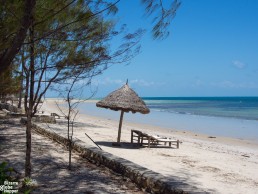
19. Go Barefoot and Breath Deep at Butiama Beach
In my opinion, the best thing about Mafia Island is its overall laid-back island vibe. There’s no need for watch or shoes, as time stands still and sand feels velvety under your feet. We lazed around in our lovely villa at Butiama Beach, amidst bending palm trees and a lush garden. It was among the best beach holidays we’ve ever had. Here you can check the rates and best deals of Butiama Beach.
There’s even a word in Swahili for the feeling Butiama creates: lala. Literally it means sleep, but here the boundaries bend more towards holistic relaxation. Beach is pristine, and you can walk in the sand for miles. Butiama Beach can arrange tours to nearby islands, sandbanks or places of interest on Mafia, including snorkeling trips to Mafia Island Marine Park. Don’t miss deliberate evening drinks at their wave-lapped beach bar while waiting for the 3-course Italian dinner.
What Else to Do in Mafia Island?
During our return flight, we got a glimpse of the stunningly sand-fringed Bwejuu island that can be reached from Mafia by boat in 3 hours. Solely two kilometers long and 200 meters wide Bwejuu must make a perfect castaway day trip. There’s even a tiny village if the beach doesn’t keep you entertained. At least camping is possible, but I don’t know if they offer home-stays.
Where to Stay in Mafia Island and Costs
There are two villages and thus areas where to stay in Mafia Island: the capital Kilindoni and Utende.
The Best Luxury Hotels in Mafia Island
As praised above, our personal hotel pick from Mafia Island is Butiama Beach: a luxurious yet affordable boutique hotel with private villas. Butiama Beach is very near Kilindoni, meaning that you can even walk to the village to visit the market and maybe grab something to eat. Their Italian restaurant is the best restaurant in Mafia Island, which is convenient as prices are all-inclusive. Rates for 2019-2020 are $160 per person per night (including private villa with patio, breakfast and a 3-course dinner, airport transfers, and free use of kayaks).
Butiama also organizes snorkeling and diving tours at several locations inside Mafia Island Marine Park, together with picnic cruises, whale watching and whale shark snorkeling trips.
Please note that when you stay in Kilindoni area (like in Butiama Beach), you don’t have to pay daily Marine Park fees. When you stay in hotels located in Utende, you have to pay daily $20 per person as Marine Park fee. So, choosing a hotel in Kilindoni means saving money!
If you still want to stay in Utende, we recommend luxurious Kinasi Lodge (from $300 per room per night, all-inclusive).
Best Budget Hotels in Mafia Island
For divers, we recommend Big Blu Mafia Island Diving Resort in Utende: It’s also an excellent diving school. Rooms are $50 per night plus Marine Park fees.
For non-divers, our budget bungalow pick is Juani Beach Bungalows in Kilindoni ($50 per bungalow per night, no Marine Park fees).
Mafia Island or Zanzibar: Which Tanzanian Island is Best for You?
We’ve visited Zanzibar: intriguing Stone Town and the far-flung paradise beaches. While most Tanzanian safari itineraries include a beach holiday in Zanzibar, we’d recommend swapping it to Mafia Island, if you’d need to choose just one island.
Why? Mafia feels more authentic than overly-touristic Zanzibar. Of course, it’s still possible to find secluded coves in Zanzibar, but it requires more legwork and patience. In Mafia, you don’t need to search for peace and quiet, you can just breath deep and enjoy your beach holiday at its fullest.
How To Add Mafia Island to Tanzanian Safari Itinerary
There’s a simple reason why Mafia Island isn’t featured in safari itineraries as heavily as Zanzibar. Most safari tour companies don’t have lodge partners on Mafia Island since Mafia lacks huge resorts. Of course, you can always book a safari and beach holiday separately: It’s easy to find and book the best hotels in Mafia Island independently.
If your safari company cannot arrange a beach holiday in Mafia Island, maybe it tells something about the company and their capabilities to go out the extra mile for you. Check out our article on how to choose a safari company in Tanzania if you’re still comparing tour operators and would like to know our insider tips!
What Does Mafia Mean? Is There Mafia on Mafia Island?
Let’s get things straight: Mafia Island has nothing to do with Italian mafia.
Mafia Island’s name has roots in Swahili expression “mahali pa afya” meaning a healthy dwelling place. Though some claim though that Moorish “morfiyeh”, a group or archipelago, might be the origin, I’m with the Swahili here.
Getting to Mafia Island
Flights to Mafia Island from Dar Es Salaam and Zanzibar, Tanzania
Getting to Mafia Island requires a scenic, short flight from either the capital of Tanzania, Dar es Salaam, or Zanzibar.
Most tourists grab the cheapest 30-minute flights between Dar es Salaam and Mafia. The local flight price is around $75 one-way. You can usually book the flights at local prices at the airport within 2 weeks of your travel dates. We booked our return flights online a month before our trip and still managed to get the same price.
When you step out of a 9-seat plane on the tiny runway on Mafia Island, you’ve already left the mundane behind. The flight itself is an exciting experience that takes you to a relaxed vacation mode. On the way, you’ll across uninhabited slices of sand amidst all the shades of turquoise and blue.
Tips for Flying to Mafia Island (And Taking Internal Flights in Tanzania)
- Check the internal flight prices from all the Tanzanian carriers: currently both Auric Air and Coastal Aviation fly to Mafia. We flew with Auric Air.
- You can also browse connection flights to Mafia Island from Arusha/Kilimanjaro and Selous. We flew from Kilimanjaro.
- Most airlines limit the checked baggage weight to 15 kg: Pack light!
- International flights arrive at Dar Es Salaam’s Terminal 2. Flights to Mafia Island, together with other short internal flights, leave from Terminal 1. The distance between Terminal 1 and 2 is about 20-minutes by foot, but you don’t want to walk with the luggage. At daytime, the shuttles connect the terminals; during the night, you need an airport taxi. Allow enough time to switch terminals.
- Leave enough time between your flights. Flights to Dar Es Salaam are constantly delayed.
Ferry to Mafia Island, Tanzania
We don’t recommend the ferry service to Mafia Island. Ferries in Tanzania are unreliable and slow. But they are also cheaper than internal flights: The ferry trip to Mafia Island costs under $10. Please note that ferries are frequently canceled and the small boats replacing the ferries are not safe. Also, taking the ferry requires getting to Nyasamati, which is a 4-hour bus trip away from Dar es Salaam.
Our Verdict: Best Island in Tanzania
We’re not hiding our opinion: Mafia Island is among the best tropical islands that we’ve ever visited – and it’s certainly the best island in Tanzania. When compared to Zanzibar and Pemba, Mafia remains off the beaten path. It’s an authentic and serene island paradise.
When hopping on our return plane, I felt like a Robinson Crusoe who was forced to leave his newly found home. But somehow I felt that we would return Mafia Island someday – too many stories were left unfolded.
Pin This Story!
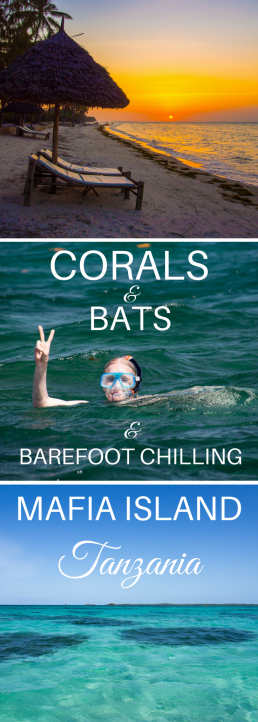
Best Snorkeling in Tanzania: Chole Bay, Mafia Island Marine Park
Many claim that snorkeling in Mafia Island Marine Park is better than in the Great Barrier Reef; for sure this off-the-beaten-path island offers the best snorkeling in Tanzania. The reefs here are among the healthiest in the Indian Ocean. For snorkelers, the park shows its best in Chole Bay, which we were happy to explore.
This article has been thoroughly updated in January 2019
Why Mafia Island Has The Best Reefs in the Indian Ocean (Better Than Zanzibar or Pemba)
Diversity in Mafia Island Marine Park is among the highest in the Indian Ocean and corals are beautifully bright. While the majority of corals around the world suffered deadly from the “El Nino” in 1998, the reefs of Chole Bay in Mafia Island Marine Park remained mainly intact. The savior was the fresh ocean water that flows into Chole Bay through Kinasi Pass at every flood tide.
The Best Place to Snorkel in Mafia Island Marine Park: Chole Bay
The horseshoe-shaped Chole Bay is the best spot for snorkelers inside Mafia Island Marine Park. The bay extends over 50 square kilometers, to the maximum depth of 28 meters. Shallow reefs are perfect for snorkeling and offer a matchless variety of marine life from soft to hard corals and schools of colorful fish.
The best part is that you are going to have all those stunning underwater sceneries exclusively to yourself. Although snorkeling here is splendid, the splendors of Mafia Island remain pleasantly unknown. Check out all the other amazing things to do in Mafia Island from our separate article.
Mafia Island is still off-the-beaten-path snorkeling and diving destination, as most tourists head to better-known islands of Zanzibar or Pemba. Although I loved the history-rich Stone Town, its street food scene, and the beaches of Zanzibar, I would still pick Mafia Island over Zanzibar for a relaxed island holiday.
Start Your Snorkeling Trip By Sailing With a Traditional Dhow Through Chole Bay
Getting to the Chole Bay is already an exciting part of the snorkeling adventure. The first surprise awaited us in the knee-high water: a wooden, traditional Swahili fishing boat called a dhow. We were expecting a modern motorboat, but this dhow turned out to be a way more atmospheric solution.
Off we sailed with happy grins, passing a few local boats transporting people and drinking water to the island of Jibondo. Lushly vegetated shores of Chole Island were soon left behind. This tiny island in the shadow of Mafia actually became the capital of the Mafia archipelago after cannibalistic Madagascans attacked Mafia in the 19th century. Several overgrown ruins just off the shore await to be explored – and would deserve a day of their own. Just after Chole rises the island of Juani, one of the largest in the archipelago. The lagoon between Chole and Juani is so shallow that you can walk between the islets at low tide.
World-Class Snorkeling In Chole Bay, Mafia Island Marine Park
After taking in the scenery for about 30 minutes, we were ready to anchor beside beautiful rock formations that are called Kinasi Pass Islets. These coral islets are also home to several birds, like fish eagles, little egrets, and ibis. There are many stunning “bommies” or coral outcrops, which are separated by sand or occasional sea-grass.
The Species of Mafia Island Marine Park
The fun began immediately after plunging into the azure waters of Chole Bay. Scorpionfish was the first to greet us, but soon after we were enveloped in clouds of tiny fish. In the next hour or so, we admired parrotfish, butterflyfish, angelfish, and Moorish idol – just to classify a few from the supposed 460 species inside the boundaries of the Mafia Island Marine Park.
Fish and corals came in different shapes, sizes, and colors. I certainly wish that we’d had a camera with us! Fragile sea fans and gold-hued fire corals emerged from the mosaic of bright colors. Blue-tipped staghorn, a gorgeous violet branching coral, was also present in great numbers.
There are supposed to lie more than 50 identified species of coral, including extinct forms, such as tabulate coral. If you are lucky, you might also spot some really weird creatures like unicornfish, giant Napoleonfish or Spanish Dancer.
Also, five species of marine turtles roam around the turquoise waters of Mafia Island Marine Park. If you’re visiting Mafia between June and September, be sure to check out the great hatching at Juani Island!
After eventually getting a bit tired and chilly, we sailed to our last location while enjoying delicious tuna sandwiches on board. The spot is called Chole Wall. The currents were stronger, which made the experience a bit different, and the corals were slightly deeper. Drifting above a huge table and brain corals felt serene anyway. In the end, we encountered a large area full of dead corals. Our guide said that at this particular spot the corals were too soft and weak to resist the temperature rise. Fortunately, the reefs here are recovering well.
The Best Year-Round Snorkeling and Diving Destination in Tanzania
Whereas snorkeling and diving are seasonal in Zanzibar and Pemba, Mafia Island is a marvelous year-round destination. The islands around Chole Bay protect the waters from the monsoon winds and make snorkeling and diving on Mafia enjoyable throughout the year.
The Best Time to Snorkel in Mafia Island Marine Park
Visibility in Mafia Island Marine Park is great, though a bit tide-dependent. The best time for snorkeling is when the tide is at its lowest, as with the outgoing tide the water becomes mixed.
Diving in Mafia Island Marine Park
There are some pretty incredible diving sites inside Chole Bay, such as sloping reefs, walls, small caves and caverns, drift, and coral gardens. Wall diving outside the bay gives an opportunity to see bigger creatures, like rays and reef sharks.
Swimming With Whale Sharks in Mafia Island
Between October and March, it’s possible to swim with the whale sharks at the other side of Mafia island, just in front of Butiama Beach. We did that in Mexico, and can’t recommend the experience highly enough!
Fast Facts About Mafia Island Marine Park
- Mafia Island Marine Park is said to offer the best snorkeling and diving in Tanzania. There’s also scientific proof that the coral gardens of Chole Bay have the best hard corals in East African coast.
- Mafia Island Marine Park is the first marine park in Tanzania.
- The marine park was founded in 1995, and it’s supported by WWF.
- At whopping 822 square kilometers, Mafia Island Marine Park is also the biggest marine park in the Indian Ocean.
- In addition to Chole Bay, the park includes the southern part of Mafia Island along with some of the northeastern areas, and the islands of Chole, Juani, and Jibondo.
Mafia Island Marine Park remains still as a well-guarded secret among diving and snorkeling enthusiasts, meaning just a handful of tourists and uncrowded sites. It’s hard to believe that the best snorkeling in Tanzania comes without the crowds!
*Disclaimer: Our snorkeling trip in Mafia Island Marine Park and Chole Bay was hosted by Butiama Beach, but all the opinions remain entirely our own.
Pin This Story!
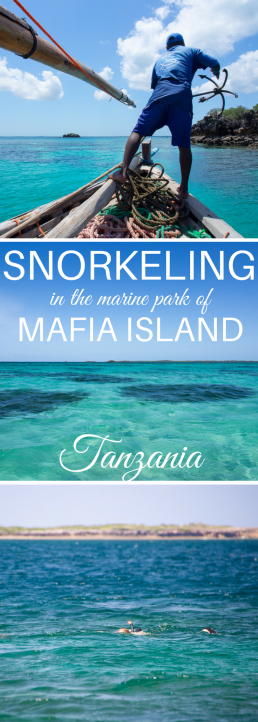
Unwind Like a Sultan at the Best Beach of Zanzibar
Zanzibar is a classic paradise island with powdery white beaches against the perfectly turquoise Indian Ocean. Known as the Spice Island, Zanzibar once was a major hub of the spice trade. The vibrant architecture and the mix of cultures still evoke tales about Omani sultans, Swahili princes, and Persian merchants multiplying the exoticness of your beach holiday.
There are serpents in this paradise, though. Since masses have already found Zanzibar, gigantic resorts spoil some of the views, and you might have to share your beach holiday with thousands of tourists and overzealous beach hawkers. Finding a secluded stretch of sand requires some legwork. Mercifully, Zanzibar is bigger than you might have thought, and there is enough space for everyone, from all-inclusive-goers to castaways and surfers.
Bwejuu – the Best Beach of Zanzibar
Still isolated Bwejuu beach at the southeastern corner of Zanzibar offered just that elusive retreat we were looking for when hearing the word Zanzibar in all of its exotic connotations. Choosing the best beach of Zanzibar is a matter of taste, but we couldn’t agree more with Conde Nast Traveler that has chosen Bwejuu among the top 30 beaches in the world. While walking by the shore of the 12-mile long sandbank called Bwejuu, you are likely to encounter a timeless idyll, unique to Zanzibar: fishermen returning from sail with their wooden dhow boats, a bunch of women scooping seaweed, and kids racing after an old ball. Luckily enough, there are only a few hotels at Bwejuu.
The Bwejuu beach itself feels pristine and endless. Ocean is tamed for swimming, as Bwejuu is sheltered by a coral reef. Tide is dramatic on this side of the island, though, which might be an issue for some. At low tide, it’s not possible to swim, but you can get another angle on the island’s colorful marine life by taking a “reef safari”: just walk to the reef without even getting your feet wet!
Time Travel to the Era of Sultans in Baraza Resort & Spa
Our requirements for a beach holiday in Zanzibar were clear: we wanted to rest our eyes on the best beach view available and sooth our senses away from the herds. We had only two days to spare at a beach location, so we wanted those days to be perfectly worry-free and relaxing before jumping into a hectic 10-day safari itinerary. We trusted Dr. Livingstone, who had stated:
“This is the finest place I have known in all of Africa to rest before starting my last journey.”
After a lot of searching, we chose Baraza Resort & Spa as our Zanzibar beach retreat. Baraza transported us through time to the era of Omani Sultans in a very decadent way. The moment we stepped down the Moorish-inspired passageway towards the reception, I felt like a sultana already. The architecture of Baraza Resort & Spa celebrates the magic of Zanzibar, merging Arabic and Indian influences into Swahili tradition. Shimmering white, palace-like buildings hide excessive amounts of gold in the form of statues, plates, and textiles. Weirdly enough, the lavish décor made me feel serene and harmonious. I felt like meditating while just looking around. The best part was to catch a glimpse of the turquoise ocean through the dramatic archways while wandering around the property. Just breathtaking!
Zanzibar is famous for intricate carvings, too, and in Baraza Resort & Spa you can see examples of the finest artisan work of Swahili furniture. Hand carved ornaments dot the cement walls and tons of locally crafted brass lanterns light the evenings. I doubt if I’ve ever seen as many lanterns, not even in a Japanese cemetery.
During our time in Baraza Resort & Spa, we were introduced to the cultural heritage of Zanzibar, as well. Swahili drummers played before our eyes while we were sipping our evening cocktails at the sofas of the Middle-East themed shisha lounge, and at one dinner a classic Taarab ensemble kept us entertained in the dark, but warm Zanzibari night. Taarab, kind of ecstatically sung poetry, was originally played in the court of Sultan bid Said, who is said to have loved the pleasures of life.
After sumptuous dinners, we were happy to stroll through lantern lit garden to our beautiful villa, where we loved to spend time unlike in any other hotel room. Every villa of Baraza Resort & Spa has a private veranda with a plunge pool, and for example, a massive Persian inspired day bed framed with golden silk curtains. After just two days’ pampering in Baraza, we felt like we’d have been on holiday for weeks. It was the most complete relaxation ever. Just like Dr. Livingstone, we were mesmerized.
The architecture of Baraza Resort & Spa celebrates the magic of Zanzibar, merging Arabic and Indian influences into Swahili tradition. Shimmering white, palace-like buildings hide excessive amounts of gold in the form of statues, plates, and textiles. The best part is to catch a glimpse of the dreamlike Bwejuu beach through the dramatic archways while wandering around the gardens of Baraza.
Choosing Between the Boutique Hotels at Bwejuu Beach
Baraza Resort & Spa is an exclusive 5-star boutique resort and one of the most luxurious hotels in Zanzibar. If this does not suit your taste or budget, there are also a few other options available at the Bwejuu beach. Whereas Baraza Resort & Spa has 30 private villas, neighboring The Palms has just six villas, offering a more small scale boutique hotel setting. The Palms falls into the same price category as Baraza Resort & Spa, but Breezes Beach Club next to The Palms serves as a more affordable option. All the three boutique hotels belong to a family owned The Zanzibar Collection, which also owns the only National Geographic Registered Dive Center in Zanzibar.
Pin This Story!
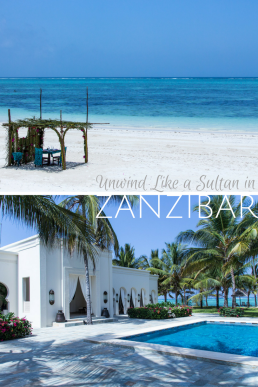
*Disclaimer: While The Zanzibar Collection hosted our stay, all opinions remain entirely our own, and the hype is real. Baraza Resort & Spa in Zanzibar is one of the most outstanding hotels we’ve visited.
Forodhani Gardens Street Food Market, Zanzibar
Everything you need to know before visiting Forodhani Gardens in Stone Town, Zanzibar! What to eat at Forodhani street food market and how to be safe, best spots to watch the sunset at the seafront and photograph fishing boats. Read on to learn more about Zanzibar pizza and other Tanzanian street eats!
Visit Famous Forodhani Gardens Street Food Market
Every night Stone Town’s Forodhani Gardens turns into a busy street food market selling fresh seafood and local delicacies, such as Zanzibari pizza. Walk by the seafront watching the sunset over the Indian Ocean while sampling street food with locals!
Forodhani Gardens is located inside Zanzibar’s historical Stone Town, by the seafront, and along the main promenade. Finding Forodhani Gardens is easy: Just walk towards the seafront, ask from your hotel or any local, or check the location from Google Maps. If you’re already done either guided or independent walking tour in Stone Town, you will know the location by heart.
Arrive Before Night Food Market to Watch Sunset and Take Photos
Arrive early to experience the unique atmosphere of Forodhani Gardens before the night food market begins. While fishermen drag their wooden dhows back to the sand, street vendors slowly set up carts and makeshift tables in the leafy walkways of Forodhani Gardens.
Walk towards the shore and take a seat at the seawall, watching tens of boys jumping off into the turquoise waters with the last rays of the sun. The seawall by Forodhani Gardens is the best place in Stone Town to take sunset photos.
While you’ve enjoyed the sunset at the dock, the Forodhani Gardens has already transformed into a lively open-air street food market, where locals and tourists alike stroll between the food stalls. Join the crowds and follow your nose to pick Zanzibari and Swahili delicacies, such as grilled lobsters and calamari, meat skewers, and samosas.
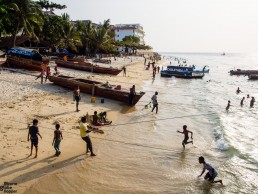
Fast Facts and History of Forodhani Gardens
The bustling place of assembly, called Forodhani Gardens, is set out between the Indian Ocean and Stone Town’s most iconic buildings, like The House of Wonders and Old Fort.
Forodhani Gardens received a whopping 2-million dollar facelift in 2009, and Zanzibaris are really proud of it.
Is Forodhani Gardens Street Food Market Safe for Tourists?
As with all street food markets in Africa, you should follow your guts and be vigilant. The street food stalls don’t match with the Western hygiene standards, and cold chain might be broken. Please consider the risks of eating street food before diving in.
The night street food market gathers crowds, which bring in the opportunistic pickpockets. Watch your belongings and take only small money to avoid big losses. Also, beware of scam waiters who take orders and cash without representing any restaurants.
If someone tries to sell you a beer, it’s a scam, as alcohol is not allowed in Forodhani Gardens street food market. Drinking alcohol might even get you in trouble, so leave it to nearby bars. The Floating Restaurant at the port is stilted upon the ocean (not floating, though): it’s perfect for sunset drinks.
Some street food vendors can be really pushy. If you are not interested in their offerings, please tell it firmly to get rid of them. Otherwise, they can harass you through the evening and even throw a tantrum if you shop in other stalls.
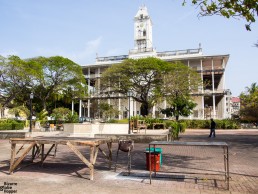
What to Eat at Forodhani Gardens Food Market
Forodhani Gardens Food Market’s selection might be overwhelming, and many tourists ponder whether it’s safe to eat street food, especially seafood. Thus, we listed the most popular dishes and further tips for avoiding stomach upset and food fails.
Fresh Seafood and Barbequed Meat – On Skewers!
Forodhani Gardens is an excellent – and affordable – place to sample seafood if you’re convinced that it’s fresh. Lobsters, crabs, squid, shrimps, and octopus are abundant, together with tasty fish, such as barracuda. Still, it might not be the freshest seafood around, so follow your nose and longest queues to find the best stalls.
The Famous Street Food Delicacy: Zanzibar Pizza
Forodhani Garden’s most famous dish is “Zanzibar pizza”: a weird mix of veggies, seafood, chicken, or beef mixed with egg and mayo and wrapped in fried dough. When the chef is piling your choice of fillings on the thin batter, it still looks like a traditional pizza. Then, an egg and mayo are drawn in, and the thing is crowned with another thin layer of dough, just like calzone. Finally, Zanzibar pizzas are fried in ghee until decadently crispy.
Is The Food Spicy?
Spice Island lives up to its name: most foods are cooked with exotic spices, such as masala, garlic, cardamom, saffron, and turmeric to name a few. Thanks to Zanzibar’s history as a melting pot of cultures, the Zanzibari cuisine has Indian, Arabic, and Mediterranean influences.
The dishes that we tried at Forodhani Gardens weren’t “hot” at all: we even asked for some extra spices!
Refreshing sugar cane juice well with any dish – add a dash of lime and ginger to boost your immunity!
Sweet treats in Forodhani Gardens Food Market
The stalls sell many kinds of Swahili doughnuts, like vitumbua, kaimati, and mahamri. You can even have a Nutella or Snickers pizza for dessert!
Hits and Misses of Forodhani Gardens Street Food Market
While some tourists have eaten the best dishes of their trip in Forodhani Gardens, the others report poor food quality and stomach upsets. Always agree on the price before ordering to avoid being charged tourist prices. Only order food at the stalls, not from the touts. Make sure your meat or seafood is well cooked to prevent salmonella and parasites.
We had just small bites and didn’t have any problems. The food we tasted was good, but not outstanding. For safe culinary exploration in Stone Town, we recommend a sunset dinner at the rooftop of Emerson Spice. If you’re looking for stunning beaches and all-inclusive resort culinary delights, we recommend a relaxing stay at Baraza Resort & Spa.
If you doubt your tolerance, please just skip the street food and explore the grounds of Forodhani Gardens. It’s well worth watching at least one sunset from the seawall with locals!
Have you visited the Forodhani Gardens street food market, if so, what was your favorite dish?
Pin This Story!
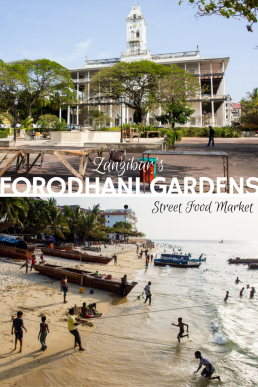
Highlights Of Nicaragua In 4 weeks: The Ultimate Itinerary
Smoky volcanoes, pristine beaches, beautiful colonial cities, crazy adrenaline activities, sleepy rural idylls and unexplored jungles – Nicaragua will exceed all your expectations. Our one-month itinerary into the heart of Nicaragua covers the main highlights with some bizarre detours: Corn Islands, Somoto Canyon, Rio San Juan and Indio Maíz Biological Reserve, the island of Ometepe along with the city of Granada, and the diversified coffee and cigar region of Northern Highlands.
Our one-month itinerary is divided into four, approximately one-week long loops, so you can easily modify it into one, two or three weeks’ itinerary – or rearrange the slots the way you’d prefer.
The Authentic Caribbean Vibes: Corn Islands (5–7 nights)
Some claim that Islas de Maíz are the most authentic Caribbean islands to be found. There is a steady flow of tourists, but both of the islands remain still quite undeveloped – Little Corn doesn’t even have roads. Prepare just to chill out and snorkel or dive, and don’t forget to feast on lobster, which is fresh and cheap. The mellow Caribbean vibes will soothe your senses and load the batteries for your tour in Nicaragua!
Getting to Corn Island (from Managua)
Fly to Big Corn from Managua (return flights about 160$ via the Nicaragua’s only domestic airline La Costeña).For logistic reasons, stay at first a couple of nights in Big Corn Island (where you’ll arrive), and then cross the ocean to the Little Corn for at least two nights. Getting to Little Corn requires taking a daily public panga (watch a video about the rough ride), occasional cargo boat or a heftily over-priced private boat.
I suggest staying the last night in Big Corn to catch your flight on time, as you really can’t count on the panga traffic. Notice also that our itinerary demands taking the first flight in the morning out of Big Corn (8 AM) to catch a connecting flight to San Juan de Nicaragua (12 PM from the same terminal in Managua, very easy change with 2,5 hours layover).
The Ultimate Nicaraguan River Adventure: Rio San Juan and Indio-Maíz (4–6 nights)
San Juan de Nicaragua and Indio-Maíz (3–5 nights)
Spend at least 2 days exploring the vast and mysterious Reserva Biologica de Indio Maíz – that’s the main reason you’ve made it this far. Prepare to see myriads of creatures up close like crocodiles, monkeys, exotic birds, and poisonous frogs. Spend some precious time with the Rama Indians, who inhabit these unexplored areas. A hike to the sacred Rama Indian pyramids was a highlight of our trip. Before booking the flights, check out our separate article: How to Organize a Trip to the Indio Maíz jungle.
El Castillo (1 night)
With colorful wooden houses and a 17th century Spanish fortress, El Castillo is hands down the prettiest town on the banks of the mighty Rio San Juan. Wander up the winding cobblestone streets and concrete walkways to the fortress to get a bird’s eye over the foaming El Diabolo Rapids, which slowed down marauding pirates back in the days.
One night was enough for us, but feel free to extend if you feel the urge just to relax. However, don’t expect wild adventures, as much of the nearby jungle is cut – and there are roads. It pays to visit Rio Bartola though if you’d like to see another side of Indio Maíz.
Getting to Indio Maíz Through San Juan de Nicaragua and Onward to El Castillo
Fly to San Juan de Nicaragua and try to book an accommodation beforehand for the nights you’ll spend there. For logistic reasons, you’d need to stay at least the first and the last night in town. We spent three nights, which became torture due to the very basic accommodation options, so I recommend just two nights if your flight and ferry schedules allow.
After your arrival, try to negotiate the Indio Maíz trip for the following day with some of the Rama Indians around. In one night (two days) Indio Maíz trip you’ll see a lot. If you are ok with staying two nights in a very basic Indian house, I’d recommend expanding the adventure. Then you could either reach further than Canta Gallo or do the same as we did but at a more tranquil pace.
On the last morning catch the earliest possible ferry from San Juan de Nicaragua to El Castillo. It’s about 4,5 hours’ journey via Rio San Juan (with the fastest panga). Usually, you’ll see many crocodiles on the way, along with beautiful sceneries.
From Beaches to Mountains: Ometepe, Granada, and San Juan del Sur (8–10 nights)
Ometepe (3–5 nights)
The picturesque island of Ometepe deserves at least three nights from your itinerary. I could have spent even more. Hike a volcano (there’s even two to pick), swim in the smooth, fresh water of Lake Nicaragua, visit Ojo de Agua, and enjoy great meals after all the rice and plantains consumed in the jungle. Devote also enough time just to unwind and admire the views over vast black sand beaches to the imposing cones. A separate article covering the enigmatic petroglyphs of Ometepe is coming out soon!
Getting to Ometepe Through San Carlos
On the last morning catch a ferry to San Carlos (1,5 hours). From San Carlos catch either a flight (convenient option) or a night ferry to Ometepe (14PM–0AM, be prepared for delays and some ripple around midnight).
Rancho Chilamate or the Pacific beaches near San Juan Del Sur (2 nights)
Cowboy up and slow down for a couple of days at lovely Rancho Chilamate. The ranch is located conveniently in the middle of Nicaraguan countryside, but only 30 minutes ride from the surf city of San Juan del Sur. Wake up to the roar of howler monkeys, collect some organic eggs with the staff if you wish, pat the pet parrot, pigs, and lovely dogs, dip in the pool and enjoy collective ranch style dinners. A highlight for us was a sunset ride with some serious galloping at a beach.
Getting to San Juan del Sur From Ometepe
Take a taxi to the port of Moyogalpa (Ometepe) and hop on the ferry heading to San Jorge (1 hour). The easiest option is to take a taxi from San Jorge to San Juan Del Sur (around 20$). Alternatively, a colectivo brings you to Rivas, where you should change to a school bus. If you fancy a top-notch horseback riding experience or an all-inclusive ranch stay like we did, Rancho Chilamate will pick you up from the town.
Granada and Mombacho Volcano (3 nights)
Get civilized among the boutique hotels, international restaurants, and pubs of Granada. There are some downsides: the beautiful colonial center is lined with tourism related services and the herds might drive you crazy. Day trips are the draw here: drastic volcanoes and tiny islands glimmering in the Lago Nicaragua await just outside the city.
Visit at least the national park of the Mombacho volcano to get a postcard view over the city and the islets. It’s easy to get there with a taxi, and an old military truck will transport you to the top. Another easy day trip with a taxi brings you to the top of aggressively fuming Masaya volcano, the gate of hell according to the Spaniards. Squeeze at least one the volcanoes into your itinerary; we visited them both.
Getting to Granada from San Juan del Sur
Hop on a school bus from San Juan del Sur. If the bus is heading to Managua, tell the driver to drop you off at the crossroads of Granada, where you can pick a mototaxi to the center. Remember to bargain!
Colonial Charm, Cigars, and Adventures of the Northern Highlands (8–10 nights)
León (2–3 nights)
Unassuming León became my favorite city in Nicaragua. It’s a crumbling colonial charmer bursting with revolutionary murals and intellectual vibe. Spend no less than two nights to experience the streetscape and allow at least one day trip. We had an epic fun volcano boarding trip to Cerro Negro and returned to the city iced with the black volcanic sand.
Getting to León from Granada
The easiest option is a daily door-to-door shuttle from Granada to León, if timetable suits your itinerary. Otherwise, hop on Managua-bound bus or minivan, and change in the capital to a León bound vehicle.
Estelí & Somoto Canyon (2–3 nights)
Streets of Estelí, the cigar capital of Nicaragua, are sprinkled with revolutionary murals. Strategic location on the Pan-American Highway, just a stone’s throw from Honduras, has made Estelí the last Sandinista stronghold and the commercial center of the north. Visiting a cigar factory is a must, even if you don’t smoke. The center of Estelí feels refreshingly non-touristic and makes a pleasant base for a few nights.
If you make it to Estelí, venture even further and spend a fun day at Cañon de Somoto. This recently “found” canyon is among the most amusing sights Nicaragua has to offer. Local guides offer kind of “nature adventure packages” mixing hiking, swimming, paddling, and plowing through the canon. You can also jump from the cliffs into the clear blue water down below – I was fool enough to jump from the scaring height of 16 meters! Check out our separate article for inspiration: Swimming Through Somoto Canyon in Nicaragua! The one-week itinerary from León to Esteli and Somoto is a must for all adventure junkies.
Getting to Estelí and Somoto from León
Expresos run between León and Estelí only twice a day, so check timetable in advance or hop on a shuttle. The trip takes around 3 hours.
We’d suggest day tripping Somoto Cañon from Estelí unless you’d like to rough it again since Estelí has some decent lodges with wifi and hot water. Take 7.30 AM expreso (1,5 hours) from Estelí to Somoto to allow enough time in the canyon. Negotiate a deal with an official guide at Somoto’s bus station to get also the transport to the site (either by bus or taxi, included in the price). The last expreso leaves to Estelí at 3.15 PM.
La Bastilla Coffee Farm (or Jinotega) (2 nights)
If you love coffee, you just have to include a night or two at a coffee farm into your itinerary. Jinotega is the best place to do it, as the area produces 80 % of the nation’s coffee. We stayed at La Bastilla Coffee Farm and Ecolodge, and enjoyed a thorough introduction into coffee growing and production. Their coffee was among the best we dragged back home from Nicaragua. Still, the best part was the breathtaking view from our porch over a cloud forest, towards Apanás Lake. The location is well off the beaten path at the altitude of 1200 meters in the Datanli el Diablo nature reserve, but your efforts will be rewarded.
Getting to Jinotega from Estelí
There are a few daily chicken buses (ruteados) from Estelí to Jinotega (2 hours), and La Bastilla Ecolodge offers private transport from the town to the estate (35$ one-way).
Matagalpa (2 nights)
Continue boozing on high-quality coffee against a backdrop of a charming mountain town. Feel free to visit nearby coffee or tobacco farms or wander in the pristine nature. We ended up enjoying mostly the garden and hospitality of our art-deco boutique hotel haven. Montebrisa B&B alone could serve as an adequate reason to visit this old Indian town: it’s one of our favorite boutique hotels in Nicaragua!
Getting to Matagalpa from Jinotega
Chicken buses connect Jinotega and Matagalpa every 30 minutes (1 to 2 hours depending on your luck). Views are to die for but expect to encounter real chickens aboard.
How to Travel in Nicaragua
We used internal flights, boats, both quicker expreso buses and slower chicken buses, taxis, and even ox-carts to travel through Nicaragua. Even if you have unlimited time and love slow travel, we’d recommend at least a couple of internal flights. For example, the Corn Islands and San Juan de Nicaragua are hard to reach without flying. The rest depends on your timeframe, personal likings and budget. We opted to stay in nice hotels, whenever they were available but were ready to rough it for the sake of adventure, as well. You can check our favorite boutique hotels in Nicaragua from this article.
If your flight time allows, it’s totally acceptable to skip Managua and start your expedition right away. It’s easy to take a taxi from the airport (Augusto César Sandino, MGA) to either León (1,5 hours), Granada (45 minutes and even less to Masaya) or Matagalpa (2 hours). Alternatively, you can take a connecting flight to Corn Islands or San Juan de Nicaragua (latest flights leaving at 1.35 PM to San Juan de Nicaragua and 2 PM to Corn Islands).
Even locals wondered how we could have seen so many places in just one month, but for us, this 4-week itinerary felt tranquil enough to take in our surroundings. Whether you’re planning a one-week or one-month tour in Nicaragua and have any further questions, just leave a comment below. We’re happy to help with your itinerary, and I can guarantee that you’ll fall in love with Nicaragua!
Pin this story!
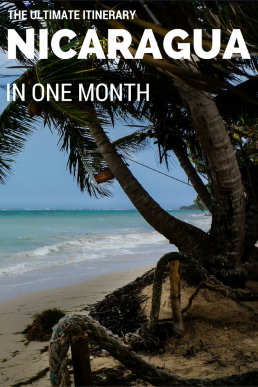
Sight Of The Week: Nathon’s Night Food Market, Koh Samui
Just before sunset, small carts gather around the old pier of Nathon in Koh Samui to form an epic food market. This is where we’ve eaten the best pad thai of our lives, and several others agree. One guy told that have had the same dish every day for several years.
Nathon is the capital of Koh Samui but at the same time only a small fishing town, and a refreshingly local spot on the otherwise extremely touristic island. At Nathon’s famous food market (Toe Roong) locals wander every single night to pick their favs and reserve the best plastic chairs to watch the life go by. There might roam a bunch of backpackers as well, but this is as local as you can get in Koh Samui.
You will be spoiled for choices, as almost every Thai street food delicacy is available. Tastes are authentic and prices cheap. We sampled chicken and pork satays along with vegetable skewers and almost everything you can imagine on a stick: char-grilled octopus, grilled corn, different kind of meatballs, and several unidentified items. Should you be into those famed insect snacks, you don’t have to disappoint, either. But if you are after the best pad thai ever, you have to find one particular cart, run by an old gentleman. One night we couldn’t find him and tried another stall instead. Once again the locals agreed: the others just don’t measure.
On Saturday evenings this gigantic street food buffet expands into a general market offering clothes, souvenirs, and other local products. Nathon is probably the best place in Koh Samui to do some souvenir shopping since prices are lower than elsewhere and vendors not too pushy. It pays to arrive early to watch a picture-perfect sunset and guarantee that your favorite street food stall doesn’t run out of goodies.
Have you visited Nathon’s night food market or sampled the street food delicacies somewhere else in Thailand?
Sight Of The Week: Isla Holbox, Mexico
Tiny Holbox is a laid-back paradise island that comes with shimmering white sand beaches and a refreshing Mexican flare. Roads are made of sand, and golf-carts are the most common way of transport. The island is separated from Yucatán peninsula by a shallow lagoon, a home to loads of exotic creatures and birds from pink flamingos and pelicans to ibis.
Although Holbox [holbosh] means “black hole” in Yucatec Mayan, this colorful Caribbean island is quite the opposite. Bright-colored, wooden houses and friendly locals invite you to spend time walking the sandy streets of a rustic fishing village (named Holbox as well), sampling fresh seafood with Caribbean flavors, watching kids playing and dogs lazing around. Distant humming of reggae might force you to one of the beach bars for a sundowner, where we happily enjoyed one of the best mojitos of our lives. Oddly enough Holbox offers also authentic Italian wood fired pizzas. Order yours with a decadent taste of tropic – fresh lobster!
Holbox is the only Caribbean island still having more than 40 kilometers of unspoiled beaches. The whole island belongs to the Yum-Balam Biosphere Reserve. Ocean reflects limitless shades of blue and green, although water is not as turquoise as in Quintana Roo in general. This is where the Caribbean meets the darker waters of the Gulf of Mexico, which also brings friendly giants nearby. Holbox is one of the best places on earth to swim with whale sharks – an experience that’s hard to beat. We swam with tens of them along with huge manta rays, and spotted also a bunch of playful dolphins.
The island of Holbox is mere 40 kilometers long and from 500 meters to 2 kilometers wide. Although walking takes you around quite easily, renting a golf cart offers a fun way to explore more remote parts of the island. We enjoyed pretty reckless driving along empty sand roads and long stretches of virgin beaches. We also stopped by to visit in a local animal refuge, Refugio Holbox. At the northern tip of the island we dumped our cart aside and hiked a few kilometers along the beach to see the famous pink flamingos. Somehow we also managed to get lost while searching for Punta Coco, a lovely beach at the eastern shore. But what a fun day it was!
Life follows the rhythm of Mother Nature, and remains simple, yet joyful. Tourism is still not dominating the scene, as fishing is the main source of income. That balance might change soon, so it is advisable to visit Holbox before the herds of Cancún will find this unspoiled paradise.
Hunting the Art Treasures And Ghosts of Vatican
Visiting Vatican in just one day may be overwhelming. The list of must-sees is long, and walking inside the labyrinth of the Vatican Museums takes time. If you are planning to stop in front of each artwork for just one second, prepare to spend five years in the Museums alone.
The mandatory highlights are the Vatican Museums, Sistine Chapel, and St. Peter’s Basilica – for touring these alone you will need at least three hours among pushing and shoving. Pick your route carefully, and take also enough time to wander off the beaten track. Play with the idea that the very same, gold wrapped ceilings that you’re admiring have witnessed papal conspiracies, ferocious ambition of rivaling artists, and loads of dark secrets that have been buried out of the way of the official history. Maybe you’ll even feel the presence of Michelangelo, the Borgia Pope or some other anxious soul who is still searching for his atonement.
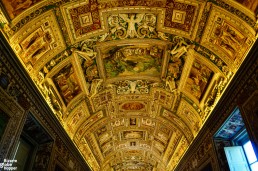
Visiting Vatican on a Guided Tour or independently?
If you don’t want to waste your precious holiday in queues, the answer is clear: take a guided tour – even if you happen to hate tours. Privileged access saves so much time that it makes even a headset tour bearable. Afterwards you can explore the Vatican Museums, Sistine Chapel, St. Peter’s Basilica, and other accessible areas on your own.
It’s much easier if someone knowing the hoods escorts you through the herds to the masterpieces you were longing to see, even if you didn’t know it beforehand. If you haven’t studied Italian art history like five years or don’t have an Italian friend who has, I really suggest a guided tour. All the official guides are art historians with a university degree. Think a guided tour as a mandatory introduction, after which you are better equipped for independent adventures: you’ve already checked most of the must-sees and are more familiar with the confusing, labyrinth-like layout of the Vatican Museums.
The good news is that there are actually great tour options available, so just take time to compare tour operators to discover the best for you. We went with When in Rome and were happy with our choice. Our small group tour aptly named “Vatican, Vatacombs, St Peter’s” covered the biggest hits with a small detour under the St Peter’s Basilica.
Our guide Chiara was without a doubt the best we encountered in the museums. She was extremely knowledgeable and her passion for art was contagious. As an added bonus she made our 4-hour hike among the herds intolerably funny keeping us alert to surprising finds all the time. She knew her place, and ordered other guides aside when we entered for example the Raphael Rooms, hence we were able to enjoy the artworks while she was pouring stories like a crazy Italian art fanatic – in a really good and entertaining way. The tour was supposed to last 3 hours, but our beloved guide got so carried away that we got an additional hour, which made everyone smile.
Touring the Vatican Museums’ Biggest Hits With Some Curiosities
The Vatican Museums embody a bitter contest between the biggest Renaissance names: Michelangelo, Raphael, and Leonardo. But let’s wander through the classics at first, since they were the source of inspiration for the later heroes.
The Belvedere Courtyard connecting Vatican Palace with Villa Belvedere is an architectural gem in its Renaissance grandeur. However, the main draw is its reputable collection of ancient Greek and Rome treasures. This is where you’ll find for example Laocoön, perhaps the most famous Greek statue in the known art history. This same marble sculpture marks the birth of the Vatican Museums, as it was the first piece Vatican bought. One lucky farmer found the statue from vineyards near Rome in the 1500s, although its missing arm wasn’t found until the beginning of 20th century.
Michelangelo admitted that Laocoön influenced his work tremendously, and of course he wasn’t the only one. Look at how precisely the motion is manifested in the muscles, how fiercely visible the veins are. Pictures cannot tell the whole story, so you just have to see it yourself. Another showstoppers are the bronze statue of Hercules and the statues of Apollo including Belvedere Torso. According your preferences visit also the Gallery of Busts or the Gallery of Animals.
Fast-forward thousand years or so, and let a few intriguing galleries lead your way towards the Vatican Palace. The wonderful Gallery of Maps proves that maps we 90 % accurate already in the 1500s. In the Gallery of the Tapestries you’ll encounter Jesus whose eyes will eerily follow your steps – one of the many optical illusions inside the Vatican.
Unexpectedly I ended up enjoying more the Rooms of Raphael than the Sistine Chapel. I blame the School of Athens, which illustrated the cover of our history book at senior high. During the lessons I used to stare at it dreaming about reviving the center figures, Plato and Aristotle. Raffaello was painting the Pope’s private rooms while Michelangelo was working with the ceiling of Sistine Chapel. Legend has it that Raffaello sneaked in the chapel to stalk the paintings, and took so strong influence, that Michelangelo accused him of plagiarism. Michelangelo despised Leonardo da Vinci, but his antipathy towards Raphael was even more evident.
Feeling exhausted already? Don’t give up yet, as the Borgia Apartments will entertain your eyes with some extravagant, though mainly religious frescos. Some call the style as “3D Renaissance”, because there are metals and fake jewels in the frescos. From here you’ll find also the first European depiction of the Native Americans, revealed just a few years ago. The notorious Borgia Pope died in one of the chambers, possibly poisoned, and the husband of Lucrezia Borgia was murdered in another. If just the walls could speak, you could get a prime lesson in plotting, treachery, and debauchery.
Finally, after several ancient sculptures, blinding amounts of gold, some early Christian sargophagi, and an endless flow of namedropping from Leonardo da Vinci, Bellini, Caravaggio, and Titian to Dalí, you’ll approach the biggest Michelangelo bomb: the Sistine Chapel.
See the Sistine Chapel in a New Light
I was surprised by how small and packed the chapel was, which flattened otherwise sublime experience a bit. Only here did our guide met her limits, since guards don’t allow speaking at all. She still tried her best by whispering into our headsets and disciplining other guides while smiling irresistible to the guards. No photos are allowed either, so excuse my detailed account, and go see it yourself!
We were the first ones to see the commanding, 14 000 square foot ceiling in literally new light, as a brand new lightning system with 7000 LEDs was installed just a day before. Even our guide was stunned telling us that colors are much brighter than before. Still I have to admit that after all the hype about Michelangelo’s 3D effect I was expecting something even more spectacular. However, this is the place to bring back all the esoteric interpretations, from kabbalah to Dan Brown, if you wish.
The Creation of Adam is replicated in souvenir and kitsch items to the level of banalising the image of finger-to-finger touch, and thus seems to be the most respected theme of our ages. But in the time of creation people valued the other scenes. While Michelangelo just copied the figure of Adam from other frescoes, for example the figures of crucified Haman and prophet Jonah showed unique technique in their sculptural poses and muscularity getting props from his contemporaries.
Michelangelo spend four years doing his magic with the ceiling, starting at the tender age of 23. He returned 30 years later to paint the Last Judgement, alone. At this time the genius didn’t want to share his honour with others. The same pride leaded him to burn all the sketches before his death.
It’s hard to pick your favorite from the vivid figures, but I’m obviously more drawn to the hell section. Michelangelo had also a twisted sense of humor, since he immortalized the Pope’s Master of Ceremonies, Biagio da Cesena, as a donkey eared god of the underworld. The same fellow had scolded the Sistine Chapel as a brothel after Michelangelo’s nude figures took the show. Michelangelo would have been furious to hear that after his death all the naked bodies received cloths. When the frescos were restored during the 1990s it was discovered that Michelangelo had placed a snake to eat Cesena’s tiny genitals – eternally. That’s what I call a sublime revenge.
With When in Rome Tours we were given a direct access from the Sistine Chapel to the St Peter’s Basilica unlike some of the other tours or independent visitors, so we could spend more time marveling the wonders of Vatican instead of exiting the whole city and then circling back through long lines towards St Peter’s. A nice add, when you have limited time.
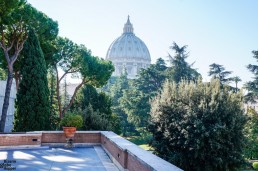
Highlights of St Peter’s Basilica
Show-offish St Peter’s Basilica boasts to be the biggest Christian basilica in the world. As a proof the measurements of other huge churches are printed on the marble of its nave. It teems with precious metals and stones, angels and statues. To fully understand its grandeur you will, once again, need a guide. Namedropping won’t stop here either, so prepare to take in the reminder of who’s who in Renaissance art.
Pièta, located in St Peter’s Basilica, is the only statue Michelangelo ever signed. Legend has it that Michelangelo heard people crediting another sculptor, which lead him to secretly sneak in and sign a band on Virgin Mary’s chest. In 1972 one mentally unstable geologist attacked Pièta with a hammer cutting its hand and nose. Eyewitnesses stole some of the marble pieces, and the nose hasn’t still been found. Nowadays the statue is protected with a bulletproof glass and ropes.
Bernini’s baldacchino stands pompously upon the supposed grave of Peter the Apostle. At the same time it marks the altar that only Pope is allowed to use. In an extremely Roman way, the bronze was ripped from the Pantheon, which aroused a lot of discussion back in the days. Baldacchino was Bernini’s first piece in St Peter’s, to be followed by the Chair of St Peter, the enshrined chair supposedly used by the apostle. Weirdly enough, there are straight allegories to woman’s pregnancy in the most sacred place of Catholic Church. Stories linger that it’s Bernini’s silent revenge against the Pope, who disavowed his nephew’s illegally born child.
Bramante designed the original layout of the St Peter’s Basilica in the form of a Greek cross, which Raphael later changed. In the end, it was still Michelangelo who finalized the plans 40 years later, after all the previous artists had died. Already 70-year old Michelangelo took over unwillingly, so you might hear the dissatisfied groans of his ghost echoing from the walls. He added a massive dome expanding Vatican’s records: with over 130 meter’s height the dome is still tallest in the world.
Enter the Vatacombs, Vatican’s Catacombs
Catacombs of Vatican sound a real blast, and as we visited the walled city in Halloween, we were twice excited. In the end, the Vatacombs turned out to be our biggest – and maybe even the only – disappointment during the day. In reality the Vatacombs are just a big hall: you are visiting the old Constantian basilica beneath the Renaissance basilica, not catacombs of any sort. There is a “tomb” of Peter the Apostle, or a structure “memorializing his original grave”, like Vatican puts it. Many of the popes are also buried down there.
The place is actually called Vatican grottoes, so we found the term catacomb extremely misleading. There is an ancient Christian necropolis beneath the grottoes, but it used to be an open-air graveyard with tombs, not a catacomb either. The real treat would still be a visit to Scavi, the excavations of that Christian necropolis. Downside is that the Excavations Office limits the number of visitors to 250 per day, so you have to book months in advance. You can try to make a reservation here. We wish you luck!
If you have been in Vatican, how was your experience? Did you make any disturbing finds? Share with us your thoughts!
*Disclaimer: Our visit in Vatican was hosted by When In Rome Tours. Like always, our thoughts and opinions remain entirely our own.
Pin this story!
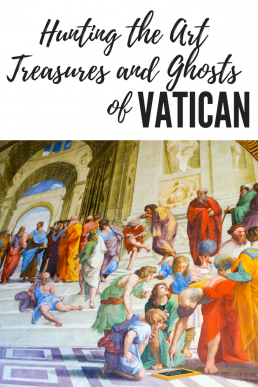
Best Christmas Markets in Copenhagen and Christmas Things to Do
Wander through the best Christmas markets in Copenhagen sampling mulled wine and roasted almonds, marvel Tivoli in its Christmas gown and houses wrapped in crazy, golden lights. Freetown Christiania’s Christmas markets bring alternative vibes to your winter visit to Copenhagen. One promise: Danish Christmas beers lighten up even the most cynical Christmas tourists. Browse our top twelfe things to do in Copenhagen to catch the spirit of Yule!
1. Visit Tivoli Gardens Christmas Market and Wander in the Gardens After Dark
You just cannot miss Christmas festivities in Tivoli! To create a true Nordic Christmas atmosphere, Tivoli Gardens are filled with small, colorful wooden houses, snowy trees, and sleighs scattered around the gardens. Say hi to Father Christmas, who waits for kids in his Christmas bazaar, and just wander around awestruck. The colorful lights leave you breathless, and chilly air might chase you to some of the idyllic, warmed terraces. Kids and adults alike love the Christmas rides of Tivoli!
Nowadays, Tivoli Gardens Christmas Market is without the doubt the most popular Christmas market in Copenhagen – and the favorite of tourists and many locals alike. The best thing: walking inside Tivoli Gardens is free.
Usually, Tivoli Gardens stay open also between Christmas and the New Year. Be sure to check out Tivoli’s New Year’s fireworks if you’re in Copenhagen on New Year’s Eve!
2. Find Souvenirs and Traditional Decorations From the Nyhavn Christmas Market
Nyhavn Christmas market is considered the most iconic Christmas market in Copenhagen. Probably because the picturesque old harbor is a perfect setting for soaking in the Christmas atmosphere. Although restaurants and terraces are overly touristic, it’s hard to beat the views – and picture opportunities. Walking by the Nyhavn waterfront is a Christmas time must for locals, as well.
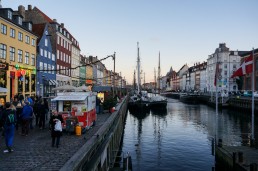
3. Sample Christmas Delicacies at Højbro Plads’ Christmas Market
If you still haven’t tasted Danish gløgg (mulled wine) and æbleskiver (Danish doughnuts), Højbro Plads’ Christmas Market is the place. Stalls have delicacies from mustard to Spanish prosciutto and bratwurst.
Højbro Plads’ Christmas market has overall old-fashioned Christmas market feel with reindeers, Santa’s sleigh, and Alpine-style log cabins. Shop woolen socks and mittens, Christmas decorations, and of course, unique gifts.
Højbro Plads (translates into High Bridge square) is right in the center of Copenhagen, so you don’t need to make a detour for quick Christmas market visit. It’s a perfect spot to escape the nearby Christmas shopping madness of Strøget.
Check out their website for full details and opening hours.
4. H.C. Andersen Christmas Market
If you still have the energy, there’s one more treat nearby: H.C. Andersen Christmas Market at Kultorvet Square. In addition to traditional Christmas food, ornaments and gifts, here you can take a photo with H.C. Andersen and Santa Claus!
Yet another central option is crowded Kongens Nytorv Christmas Market, which has a beautiful setting between the overflowing Christmas decorations of D’Angleterre Hotel and Magazin department store. By the way, D’Angleterre serves the fanciest glogg (mulled wine) in Copenhagen, if you’re in the mood!
By now, you probably agree with us: Copenhagen has some of the best Christmas markets in Europe!
Within one month, we visited Christmas markets in Denmark, Austria, Hungary, Estonia, and Finland. As much as we loved them all, Tallinn’s Christmas Market remained as our all-time favorite, where we’ve even visited many years in a row. Check out our article about the charming, Medieval Christmas Market of Tallinn’s Old Town to find out why!To our joy, Helsinki’s Christmas markets have lately been listed among the best European Christmas markets in Europe. Check out our full guide to Helsinki Christmas Markets and fall in love with our home city!
5. Soak in the Bohemian Atmosphere of Christiania’s Christmas Market in the Grey Hall
Everyone comes here for the traditional, bazaar-like Den Grå Hal (The Grey Hall) Christmas market, also known as (Christiania Julemarked (Freetown Christiania Christmas market). Stalls are located inside a former dressage hall, which is convenient if the weather is awful. The stalls have an alternative feel, carrying also other treats than Christmas handicrafts and decorations.
But the Grey Hall Christmas Market isn’t the whole story in here. Delight in the idyllic surroundings of Christiania, secretly photobomb the wooden hippie houses with Chrismas decorations and enjoy warm drinks in cozy Månefiskeren or some of the nearby cafés.
6. Christiania’s Other Christmassy Things To Do: Elf Theater & Gallopperiet
Christiania’s Gallopperiet aka Stadens Museum for Kunst (Christiania Art Museum) is usually transformed into smaller scale julemarked (Christmas market) in December. Browse characteristic handicrafts along with bohemian art while enjoying warm drinks and live music in a relaxed atmosphere.
Christiania Børneteater offers hilarious, old-fashioned elf performances every weekend during December. Productions are suitable for kids and adults, and latter may enjoy Christmas beer or mulled wine on the side.
7. Combine Sightseeing at Kronborg Castle’s Christmas Market
If you’re in Copenhagen during the first two weekends in December, tick off Kronborg Castle from your bucket list and get your Yule spirits rising in the traditional Christmas market, which spreads inside the courtyard and ballrooms.
8. Sample Mulled Beer at Carlsberg’s Christmas Market
You read it right: this is Copenhagen’s gift to all beer lovers! If your visit to Copenhagen coincides with the first three weekends of December, make your way to Visit Carlsberg, the factory and adult playground of the world-famous Danish beer. Brewer’s courtyard hosts stalls selling Danish Christmas delicacies (roasted almonds, æbleskiver, and snacks), gift ideas, and naturally: special mulled beer!
There’s even a free shuttle service from Copenhagen Central Station: read more on Carlsberg’s site.
9. Pop In and Out the Christmas Shopping Fever of Strøget (for LEGO Christmas!)
The pedestrian street Strøget offers some serious present shopping opportunities. We don’t quite understand the Christmas shopping frenzy but enjoyed popping in the LEGO Store (Vimmelskaftet 37) to see a different take on Santa’s village and his sleigh. The side streets of Strøget have some alternative shops that fit our taste better.
10. Get Christmas Decoration Overload in Centralhjørnet
After visiting the best Christmas markets in Copenhagen, you still have one Christmas time must-see. Copenhagen’s oldest gay bar Centralhjørnet (Kattesundet 18) is famous for its overwhelming Christmas decorations.
If you haven’t yet tasted Tuborg Christmas Brew, do it here. Bizarre fact: Tuborg’s Christmas brew is sold only for ten weeks but comes up as the fourth best-selling beer in Denmark.
11. Taste Danish Christmas Brews in Mikkeller & Friends
An adorable Danish microbrewery Mikkeller has two brewery bars in Copenhagen. A larger one, Mikkeller & Friends, is located in an upcoming hipster neighborhood of Nørrebro (Stefansgade 35). They have 40 daily changing beers on tap, and 200 more in the adjoining bottle shop. We sipped some interesting Christmas brews, both from Denmark and abroad.
Tasting the latest brews at Mikkeller is always among our favorite things to do in Copenhagen. If you’re extremely short on time, now you can do it also at the Copenhagen airport. The best news: Mikkeller’s airport bar & bottle shop is always open!
12. Shop Delicacies at Irma Supermarket
This is the easiest tick, as Irma’s are found everywhere around the city. We were stunned by the wide organic selection and stocked on snacks, raw chocolate bars, and handcrafted beers. Irma Supermarket is the place to buy edible souvenirs from Danish gouda to pastries and sweets. We happily stumbled on a Christmas beer sampling session, too.
What are your favorite Christmas Markets or other things to do in Copenhagen during Christmas time? Where have you spent the most memorable moments: in the alternative Christmas venues of Christiania, atmospheric Tivoli Gardens, or at Copenhagen’s traditional Christmas markets?
Pin this story!

Independent Beat Generation Walking Tour in San Francisco's North Beach
Follow the footprints of the Beat Generation in San Francisco’s North Beach neighborhood! We dug out the landmarks and favorite spots of Beat poets and crafted an independent Beat Generation walking tour in San Francisco. Spend an afternoon exploring North Beach, grab your copies of beat poems in City Lights Bookstore, sip espresso in Caffe Trieste and gulp down beers in Vesuvio Cafe, photograph the murals of Jack Kerouac Alley and pop in the Beat Museum. Finish off by savoring cocktails in a former opium den – or check out a handful more beat locations in other parts of San Francisco!
Follow the Footsteps of Beat Generation to San Francisco’s North Beach
It’s still possible to “feel the beat” in San Francisco, as a surprisingly vast array of the original 1950’s Beat Generation hangouts are happily alive. The most famous bars and cafés are clustered around the legendary City Lights Bookstore (261 Columbus Ave) in North Beach area, so let’s start our independent beatnik walking tour from the heart of it all!
North Beach is very central, so you can either walk there with Google Maps or take a taxi to City Lights Bookstore.
The Famous Beat Bookstore in San Francisco: City Lights Bookstore
Graffitis and street musicians welcome you to the most iconic Beat landmark in town. The oldest all-paperback store in the US is still owned by its founder Laurence Ferlinghetti: a Beat poet, bohemian and philosophical anarchist. Ferlinghetti was Ginsberg’s loyal publisher and also published other Beats like Burroughs, Corso, Kaufman, and Kerouac.
City Lights Bookstore served as a living room for the Beats who were looked down by the mainstream. In The Fall of America Ginsberg labeled it simply “home”.
Buy and Read the Classics of Beat Literature
Time stands still behind the shelves of City Lights Bookstore; I guess nothing has changed immensely in 70 years. Just grab a book and find a seat from the benches of the basement or the poetry room, where also the Beats gathered – you are allowed to read here. We spotted inspiring discussions between the shelves, too.
City Lights Bookstore is the perfect place on earth to stock on Beat literature. You might be tempted to buy Kerouac’s On the Road, as I did, committing a slight faux pas since the book is published by Penguin. City Lights stocks several editions of On the Road.
The collection at City Lights is wide: we picked one book on Mexican drug trafficking, Tibetan Book of the Dead and some Native Indian mythology to the go. Whatever you might find, don’t walk out without “Howl” in your hand.
Allen Ginsberg’s “Howl” remains the most famous poem ever written in San Francisco. It sums up excellently the mood of the Beat Generation poets and the narrow-mindedness of the surrounding society. The scandalous book was published in 1956 by City Lights and banned shortly after making Ginsberg a national hero. Obviously, from here you’ll find a lot of publications dealing with the famous trial process, as well as several editions of “Howl and other poems.”
Hunting the Art Treasures and Ghosts of Vatican
Ghost Stories of the Forbidden City
Visiting Dracula’s Castle in Romania
Indulging in the Decadence of Lord Byron in Rome
Support The Beat Museum for a Good Cause
If you still need a fix, visit The Beat Museum just around the corner (540 Broadway). It hosts a small and weird collection including Kerouac’s liquor store bill, Neal Cassady’s shirt and Kerouac’s jacket along with letters and first editions. They have also a webshop for real enthusiasts, so you can order your Beat t-shirts and collectible items online.
Right now you can show your support to the great cause by helping them to raise enough money to acquire recently found Neal Cassady’s lost letter aka “Joan Anderson Letter”. This letter inspired Kerouac to rewrite “On the Road” in the stream of consciousness style, so its impact on his work was tremendous.
What Does “Beat Generation” Mean and What Was Their Impact in San Francisco?
Jack Kerouac was first to call the poets of the new literary movement “Beats” and “Beat Generation” in the 1940s. At first, the term implied weariness; later the connotations of jazz and beatific spirituality were added.
The Beat Generation, also called Beat movement, questioned post-World War II mindset, materialism, and traditional values; played with taboos and indulged in hedonism and psychedelics. Their writings were provocative, straightforward, and expressive.
Beat Generation in San Francisco
The Beat Generation wanted to bring poetry back to the streets from academic circles. City Lights Bookstore and Six Gallery hosted chaotic readings, sometimes soundtracked by jazz. They paved the way for female, black, and queer poets – and everyone else outside the gray suits and mainstream.
The core group of the beat generation consisted of Jack Kerouac, Allen Ginsberg, William S. Burroughs, Gregory Corso, Neal Cassady, and Laurence Ferlinghetti. Kerouac, Ginsberg, Cassady, and Burroughs were the first group of friends, who met initially in New York, and expanded the movement as they migrated to the bohemian San Francisco. The second wave of beat writers included Bob Kaufman and Ed Sanders among others.
The Beat poets created a counterculture movement that defined later a whole generation – and rooted bohemian literature and arts in San Francisco. As Laurence Ferlinghetti turned 100 years in March 2019, San Francisco’s mayor declared March 24th Laurence Ferlinghetti Day. Without the Beat Generation, San Francisco wouldn’t be the city it is today.
Herb Caen’s Terms Beatnik and Baghdad by the Bay
In 1958, Herb Caen invented the term “Beatnik” in this column – 6 months after the Sputnik was launched, implying that the Beats were as far from the mainstream as the satellite. The beats, including Kerouac, were mad at him. Kerouac even asked Caen to stop using the term, but the media had already adopted it. Later, the Beat poets made parodies out of “beatnik” – and Herb Caen.
It’s easy to imagine why Herb Caen called San Francisco “Baghdad by the Bay” in the late 1940s. By then the city felt like Babylon with its mix of cultures, nightclubs like screaming minarets, and cramped streets filled with wild adventures. Luckily, you can still catch the distant beat touring these Beat Generation hotspots!
The Favorite Cafes, Bars, and Landmarks of Beat Generation in San Francisco’s North Beach
After you’ve explored City Lights Bookstore and the Beat Museum, it’s time to take it easy and drift from one beat bar to another.
Meet the Fans of Beat Generation in Vesuvio Cafe (255 Columbus Ave)
Vesuvio Café is conveniently located just across City Lights, which makes it easy to pop in. The clientele consists of artists and exotic dancers like back then – accompanied by herds of Beat hungry tourists.
The pub got its place in the Beat Generation history after Neal Cassady stopped by one autumn night in 1955 on his way to Six Gallery reading. Soon after Kerouac and other Beats became regulars. When Jack Kerouac was supposed to meet Henry Miller, it was the spirit of Vesuvio that delayed him over and over again: He opted to drink instead of driving to Big Sur to meet Miller.
Nowadays, Vesuvio is the most famous “Jack Kerouac bar” and Beat Generation watering hole in San Francisco.
Photograph the Murals of Jack Kerouac Alley
The narrow passage separating Vesuvio from City Lights got aptly entitled Jack Kerouac Alley in 1988. Take a few fan shots with street signs, citations, and murals before moving on to the next Beat joints.
Follow the Footsteps of Laurence Ferlinghetti to Caffe Trieste (601 Vallejo St)
Drop in the nearby Caffè Trieste, the oldest espresso house of the West Coast, to sip some of the best coffee around and enjoy the vibes of Little Italy.
Besides Beats, you can pay homages to Francis Ford Coppola, who wrote much of the Godfather here. As an added bonus you still have a good chance to bump into Laurence Ferlinghetti – or other writers, including Andrew Sean Greer who won Pulitzer in 2018.
Sit With the Golden Buddha in Li Po Cocktail Lounge (916 Grant Ave)
A short stroll down Grant Avenue brings you to Chinatown. Receive the final beatification in Li Po Cocktail Lounge (916 Grant Ave), one of my favorite bars in San Fran.
Celebrate the beatific day with their famous Chinese Mai Thai, if you dare. We settled with two Lucky Buddhas to marvel this old opium den, where Beats used to hang around. Inviting, red leather booths and Chinese lanterns still cheer spontaneous conversations under the serene stare of the golden Buddha statue.
The already departed Six Gallery (3118 Filmore St) lay a bit farther from the golden triangle of City Lights, Caffè Trieste, and Li Po Lounge. It was where by then unknown Ginsberg read “Howl” the first time. The following day Ferlinghetti sent him a message in the same words that Emerson wrote to Whitman a hundred years earlier: “I greet you at the beginning of a great career”, and the rest became history.
The Other Beat Landmarks in San Francisco (Outside North Beach)
Whereas North Beach is titled the official Beat neighborhood, the whole city carries allusions to the works of Beats.
When Kerouac ended up in San Francisco for the first time, he lived in Marin City in his friend’s shack visiting the city itself infrequently – this is the period he allocates in On the Road. Kerouac never really lived in San Francisco, although visited the city periodically crashing at his friends’ places. In the attic of Neal and Carolyn Cassady’s house (29 Russell Street, Russian Hill) he stayed several months during 1951 and 1952 while working on Visions of Cody.
If you cross the bay to Berkeley, be sure to visit Moe’s Books (2476 Telegraph Ave), another Beat bookstore that hosted poetry readings – and still does.
I tend to romanticize San Francisco beyond the limits: strolling the hilly streets lined with crooked, pastel-colored Victorian houses and taking in the views while hanging out from an old cable car. But so did Kerouac, so just soak in the same bohemian frenzy this fog city creates.
We enjoyed a 5-day layover in this fog city after our summer holiday in Mexico. Touring the sights by day, foodgasm and exploring the darker side of the city by night filled our stay with pleasant surprises. Check out this Quirky Independent Bike Tour to the Golden Gate Bridge Via Abandoned Pet Cemetery. Circling the Beat generation landmarks and hangouts was only one of our detours, so if you got interested, come back later to check our 5-day itinerary into San Francisco’s famous sights and bizarre treats.
Pin this story!
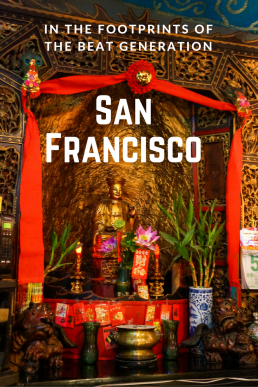
Indulging in The Decadence of Lord Byron in Rome
Rome captured the imagination of Lord Byron like so many of my favorite writers. Since the Eternal City has a luxurious boutique hotel carrying the name and the mood of the man himself, how could you resist the splurge? This elegantly decorated Art Déco manor bursts tales of romance and past time grandeur offering a truly unique setting for romantic getaways.
Capturing the Essence of Lord Byron
George Gordon Byron, or simply Lord Byron, was one of the most prominent figures of British Romanticism in the 1800’s. Byron was also known as the most notorious poet of his times. His greatest legacy was the concept of Byronic hero: emotionally complex, dark and impulsive young man prone to strong feelings of desire and despair.
Lord Byron’s most celebrated work Don Juan depicts the protagonist as a rather naïve man seduced by women, not vice versa as the original legend goes. The poem was widely criticized for its immoral content, and it’s said to mirror Byron’s own rather complicated escapades.
“A man must travel, and turmoil, or there is no existence.”
–Lord Byron
The patrician villa of Hotel Lord Byron will transfer you in the era of eloquence and “the spontaneous overflow of powerful feelings” like the Romantics themselves put it. Belle Èpoque merges elegantly with 1930’s Art Déco: antique-filled salons combine warm colors and delicate ornaments with attention to period details. The walls are said to illustrate Lord Byron’s amorous lifestyle with original 1930’s masterpieces of elegant ladies.
32 guest rooms and suites are individually decorated with Art Déco furnishings and precious textiles. Some have a private terrace overlooking the gardens of Villa Borghese, and the upper suite has even a prestigious view of St. Peter’s church. Luxurious bathrooms with Carrara marble and toiletries by renowned perfumer Lorenzo Villoresi add a proper dash of decadence.
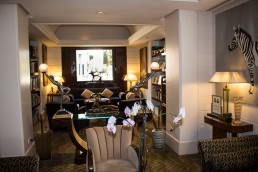
The Origins of the Hotel Lord Byron
Hotel Lord Byron feels like a home of a widely traveled aristocrat, like Byron himself. The name is no coincidence. Byron lived in Italy for 7 years during which he wrote Laments of Tasso, inspired by his visit in Torquato Tasso’s cell in Rome, and started Don Juan. In his own words, Rome “delighted” him. Although some historical junctions can be found, ultimately the name represents hotel owner Amedeo Ottaviani’s adoration for the works of Byron.
The history of the manor is interesting, too. The white limestone façade resulted in hotel’s nickname the “White House”. The property was designed by an anonymous architect in the 1930s. One of the early owners financed in part the restoration of Basilica San Francesco d’Assisi. At some point the house has been a girls’ school, when there obviously have been tens of tiny rooms instead of present spacious suites. Hotel Lord Byron was established in 1962.
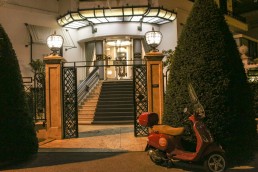
The Quiet Splendor of Villa Borghese
Hotel Lord Byron is a luxurious retreat from overly touristic center historical, yet walking distance from the main sights. Location is secluded, surrounded by embassies and old mansions, just few steps from gorgeous gardens of Villa Borghese, where Lord Byron himself used to visit, and where you can find his statue overlooking the estates.
Leisure 15 minutes stroll brings you through the pleasant Borghese park to the bustling Piazza del Popolo, from where you can easily wander through shopping streets to center historical in another 15 minutes or so. Some of the Rome’s most iconic sights like the Spanish Steps and Trevi Fountain will deftly fall into your route.
A side note for all literature fans out there: the neighborhood around the Spanish Steps and Piazza di Spagna is where Lord Byron and other expat artists lived in the 1800s. Keats-Shelley house (26 Piazza di Spagna) houses a small museum with a room where Keats died, an exclusive library with early printed volumes of Romantics, and studies of Byron’s work. Writers like Byron, Goethe, and Gogol frequented the nearby Antico Caffé Greco (86 Via Condotti).
Hotel Lord Byron is flamboyant and a bit decadent in its glamour like Lord Byron himself. Our stay in this exquisite 5-star hotel completed our Roman holiday in a way no other hotel could have done. If you appreciate art and history along with an intimate and sedate atmosphere, you cannot go wrong here.
Even if you end up staying somewhere else, I’d recommend an aperitif in the glamorous “Il Salotto” lounge bar just to enjoy the exquisite art collection of Hotel Lord Byron. Sapori del Lord Byron restaurant offers the regional specialities of Rome and their award-winning wine cellar has a private table for two for those special dinner moments.
*Disclaimer: While Hotel Lord Byron hosted our stay, all opinions are entirely our own.
Canta Gallo – Ancient Rama Indian Pyramids Deep in the Indio Maíz Jungle, Nicaragua
Thousands of years old stone pyramids lay intact deep in the jungle of Indio Maíz, southwestern Nicaragua. Some call it a lost city of ancient Indians, but little is known about the history of these structures. The site, called Canta Gallo, is sacred to Rama people, descendants of the Chibcha Indians.
“This is where our ancestors used to meet”, our guide Margarito says and points at a giant stair-like stone pyramid amid ground vegetation. He sits calmly on the stairs to tell us some incredible stories with his broken Creole English, mixing in words of Spanish like the Rama Indians do.
We had traveled eight hours in a small fiberglass boat from already remote San Juan de Nicaragua, overnighted deep in the jungle with chickens and bats, and trampled one hour through thick vegetation to get to Canta Gallo. I didn’t know what to expect, when Salomon, a Rama Indian, who initially brought us down the Rio Indío, asked in the morning if we would like to see the pyramids of Canta Gallo. For sure I wasn’t expecting this.
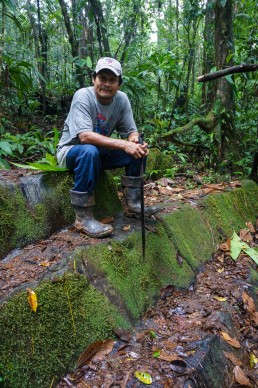
Zigzagging Between the Stone Pyramids of Canta Gallo
After trudging past a few smaller, turtle-like stone structures and those stairs, we finally arrived in the main area of Canta Gallo, where we spent an hour or so zigzagging midst the ancient Indian pyramids and walls. Rays of the early morning sun cast an air of magic over gigantic rock formations. Bluish gray stone slabs are piled up to form huge stone balls and pyramids that might be over 20 meters in height. The Rama told us that these structures are known to date back from 3000 to 5000 years.
Suddenly I hear Salomon talking and pointing a stone structure with a puzzling look: “Here seems to be a fish”. Stone faces have ancient inscriptions, but even the Rama Indians can only guess their meaning. The pyramids of Canta Gallo are currently researched by the University of Bluefields, but there aren’t any written information available yet.
I lost the count while we wandered around awestruck, we must have passed more than ten massive pyramids and some smaller structures. Our guide Margarito kept asking if we would like to see a few more – how could we have declined even though we were already dehydrated, and thus at the edge of our strength. Passing a small river and a waterfall to reach the main pyramid was among the highlights for us. The moment felt so special: no other people had visited the site for days, exotic birds were chirping, and nail-sized colorful, poisonous frogs jumping around us. Even the mid-day sun blessed us, which is a rare treat in Indio Maíz.
Religious Rituals and Unbelievable Legends of Indio Maíz
Stories poured in as soon as we stepped into the jungle from our tiny boat. Legends start with the name: the place is called Canta Gallo according to a rooster (gallo), which is said to appear screaming (canta) at this godforsaken spot once a year – nobody knows how it’s even possible.
According to the Rama Indians, Canta Gallo is where their ancestors practiced religious rituals and gathered to deal with community issues. The site has served as a haven, where the Rama have escaped foreign conquerors. Canta Gallo where they hid from Spaniards 500 years ago, and later Miskitos, British, and Sandinistas respectively. Little is known about the ancient rituals – and little is told if someone has the knowledge.
Getting to Canta Gallo Through Rio Indio and Indio Maíz
Canta Gallo is well off the beaten track. You’d need to travel deep into the Indio Maíz Biological Reserve, so you’d need a guide with a boat. It takes one day to get there, and the second to tour the ruins. Our boat trip from San Juan de Nicaragua lasted 8 hours, following the Indian River, Rio Indio, all the to the Canta Gallo. As there are slightly faster boats available (just prepare to pay more for your gasoline and boat rent), the Ramas are hoping that in the future visitors could see the pyramids on a day trip from San Juan de Nicaragua. If you were daytripping, the tour would still take at least 11 hours – assuming that river conditions are favorable, and you don’t take any breaks. I recommend spending the night at a local Indian home near Canta Gallo, both for your convenience and the experience itself.
If you embark on the Indio Maíz trip with a Rama Indian guide as we did, he’ll hire another Rama to take you to the ruins. At the moment, the Rama use three locals, who know the route best. Our guide Margarito also takes overnighting guests in his house, which lies approximately 15 minutes by boat from where the path starts. We stayed at his neighbor Javier’s house, on the bank of Rio Indio. If you are planning to visit Indio Maíz and Canta Gallo, check out our recent article on how to organise a trip to Indio Maíz for further details.
Hiking to Canta Gallo from Rio Indio
When Salomon asked if three hours’ jungle trek might be too much for us, we laughed at him thinking this old Indian might be the weaker one of the bunch. However, the hike to Canta Gallo proved to be pretty challenging and extremely muddy, although it wasn’t even rainy season yet. Prepare with lots of water – we had only half liter per each, which was ridiculously little.
The first kilometer was filled with mud, as we hiked through a swamp. With United Nation’s financial help Ramas had built a few bridges over the wettest parts, which made the trip a lot easier. Still, we had to plow through smaller rivers. Piritta’s rubber boots were leaking, but I was happy, though clumsy, in my five sizes too big boots. Don’t even try it in sneakers, use the rubber boots Ramas offer.
After a wet start, we climbed for almost an hour through the dense jungle. At first, there was a visible path, which soon disappeared. Margarito opened the way with his mighty machete, hitting blazes in the trees for the next hikers. It would have been impossible to find the ruins without a guide. A plethora of poisonous frogs came in all sizes and birds had names I’ve never heard. Tree trunks and even roots were enormous, bushes and vines clutched our feet. I tried to evade spider webs or, at least, the poisonous arachnids, which were plenty. Capuchins, howler monkeys, and spider monkeys warned other creatures as we approached.
We ascended about 600 meters above sea level while the Rio Indio is a few meters. Hillside was wrapped in a weird, gray haze. It wasn’t the usual fog cloud forests have, and even the Rama Indians call it “smoke”, which made me ask of its origin. Salomon told that every tree produces a gallon of oxygen in a day. Multinational companies have expressed their interest in the area, but the Rama are not willing to sell land. These guardians of the forest want to figure out why and how this process is different here, and if it could be simulated somehow to help the planet.
The Rama had built a basic hut on the top of the Canta Gallo hill, where we steadied our breath for a few minutes before a short, but quite steep descend to the ruins. When Salomon told us about their hopes of building a causeway over the swamp and expanding this hut into accommodation for visiting tourists, I felt a bit downhearted. I really hope the Rama will get the proper appreciation as a nation, and I know it requires publicity for their heritage, in the form of both tourists and the UN. These construction projects will make this place more accessible, and thus more visible. I’m just a bit concerned that the magical Canta Gallo might lose its authenticity. If you got interested, please go there before everyone else will.
Nicaraguan Conspiracy Against Their Heritage
Whereas Canta Gallo has had a special meaning to the Ramas for centuries, officially it’s a new find. Canta Gallo hit the news less than ten years ago, when a foreign photographer claimed to find these pre-Colombian Indian pyramids. It was said that they were kept as a military secret. By then government declared that the pyramids were just volcanic lava outcrop. Stories conflict, as some of them place the discovery to 1998. However, Canta Gallo hasn’t been common knowledge for long, and its birth is still neglected.
Honestly, I don’t know what’s the official truth at the time of writing, but I’m hoping that the Canta Gallo pyramids will get the position in Nicaraguan history they deserve. When some people in San Juan de Nicaragua – even the Rama Indians – told us that the Canta Gallo pyramids were made by volcanic lava cast, it sounded weird to me. The way people expressed it felt like an insult to the historical heritage of the place.
Facing the Truth and the Spell of the Jungle
After some research on columnar basalt, I may have to accept, although willy-nilly, the scientific explanation of the birth of these stone benches. Yeah, it spoils some magic. But does it have to? Even if these eerily man-made looking pyramids are formed by a special kind of volcanic lava cooling process millions of years ago, it makes them a stunning geological wonder. Geologists claim that these basaltic columns date back to the Tertiary period, which extends from 66 million to 2,58 million years ago.
From cultural-historical viewpoint, the thing that matters is how ancient Indians used these structures. Basaltic columns have carvings, but could archeologists define their age and meaning? Are there any other clues, which would give us more information about these mysterious structures? Whatever the history might be, the site itself is beyond words and it’s sacred to the Ramas. In my opinion, our hike to Canta Gallo bet our visits in Machu Picchu and Angkor Wat, because the grounds are so immaculate.
There are said to be 22 archeological sites in the Indio Maíz area. Canta Gallo left me longing for more. I’ve heard astonishing stories about the ruins further up the river, where a lake and a tree might just disappear. Sounds like a fairytale, but after visiting these captivating grounds, I wouldn’t be surprised to find some real magic deeper in the jungle. Some places are so sacred that the Rama Indians won’t take tourists there. There are stories about unlucky army officers, who’ve tried to venture into the Rama territory with bad intentions and met their fate at the hands of the jungle guarding spirits. I’m more than eager to hear if you’ve visited Canta Gallo pyramids or Indio Maíz: what did you find?
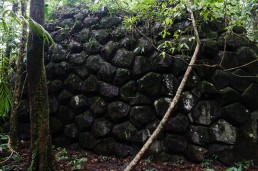
Pin this story!
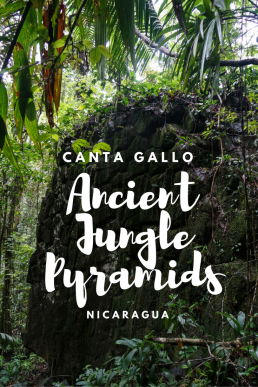
Pick Your Paradise From Tiny Gili Islands: Gili Trawangan, Air or Meno
Are you still looking for that perfect paradise island with beautiful beaches, turquoise water, and world-class snorkeling? Gili Islands in Indonesia are touristy enough to offer nice accommodation and laid-back beach bars, yet without massive crowds. You won’t find any motorized vehicles, just horse-carriages, and pure relaxation.
Gili Islands dot the pristine Bali Sea just outside the shore of Lombok. The 35-kilometer boat trip from Bali will take around 1,5 hours with the quickest speedboat. Gili Trawangan is the main tourist draw being also biggest in the measure, but having still only 1000 inhabitants. All boats from Bali, if not chartered, will dock on Gili Trawangan from where you can take a long-tail boat to the others. Combine two or three Gili Islands to make sure your vacation isn’t lacking anything except more time in this mellow paradise.
Escape the Madness of Bali to the Gilis
Despite the collective paradise illusion, the island of Bali is polluted with scooters, all-inclusive hotels, and omnipresent drug business. If considering a truly relaxing beach break from the madness Bali, you have practically two choices: neighboring Nusa Lembongan or the Gili Islands. The former is easily accessible from Bali in less than half an hour, which brings in the herds and day-trippers.
Gili Islands can still be labeled as serene paradise: no cars, scooters or any other motorized vehicles, only horse carriages and roads made of sand. Perfectly turquoise water, inviting acid-world of kaleidoscopic coral reefs, and fantastic views of Rinjani volcano on the neighboring island of Lombok – do you really need more excuses? Although Gili Trawangan has been on a backpacker trail for decades, when compared to Bali, even Trawangan remains on the road less traveled.
Which Island to Choose: Gili Trawangan, Air, or Meno?
If you love islands and have enough time, choose all Gilis! We picked the extremes: the party island Gili Trawangan and the quietest one, Meno. Gili Air is something in-between: a popular choice for families, honeymooners or couples yearning for real restaurants.
All three islands offer the same high standard of snorkeling and diving. Because the Gilis are located close to each other, snorkeling and diving trips can include the same spots. In my opinion, Meno has the best beaches, there’s also less boat traffic, which makes snorkeling more pleasant.
Trawangan provides nowadays all kinds of accommodation, even luxury villas. On Gili Meno, there aren’t many places to choose from, but the scene is changing slowly as Gili Trawangan doesn’t have any free land left. But luckily Gili Air is the next one to fill up.
While Gili Meno is the most “primitive” of all three, it’s also the most expensive one for tourists. Prepare to pay more for accommodation and gain less comfort for your dollars. Besides beaching it, the waves at the sunset point of Trawangan are suitable for surfing. We went horseback riding, rented bicycles and just wandered around – I’ll write a separate story of our idle days in paradise including some snorkeling tips.
If you choose to stay on one island only, be sure to hop to others. Local boats connecting all three operate in the mornings and afternoons.
Getting to the Gili Islands: Speedboat From Bali to Gili Trawangan
As speedboat traffic between Bali and the Gili Islands has increased tremendously, safety standards have gone down. So it might be wiser to choose a reputable company than to save a few bucks.
After shopping around, we chose Gili Cat and were quite pleased with it (list price for return tickets was about 1 000 000 IDR, but remember to bargain). Our journey took around 2,5 hours.
Padang Bai harbor in Bali is quite a mess, to be frank. Bare with frenzied street sellers, and look after your belongings. Just don’t take that fancy suitcase with you, because wheeled bags are not very practical on sand roads, and would look rather funny in island scene. Boats anchor offshore in Gili Trawangan, so prepare to wade in the shallow water for a few meters.
A more expensive option is to fly from Denpasar (Bali) to Lombok, catch a taxi to the harbor and take a boat to Gili Trawangan. It might sound quick, but it might as well take more time than a speedboat depending on where you start your trip and how well plane’s schedule matches with local boats. Local boat from Bali to Gili Trawangan serves as a slow budget option, but due to safety reasons, not a very recommendable one.
If you’re planning to explore Bali, check out this 2-week Bali itinerary for the first-timers.
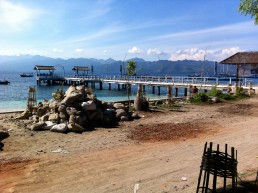
Are Gili Islands Not For You?
Few words of warning: weed and magic mushrooms are openly available everywhere on Gili Trawangan. We found those “instant ticket to moon” signs rather funny, but keep in mind that any drink or food having an attribute “magic” will contain hallucinogens.
Booze-fueled parties are concentrated on Gili Trawangan’s main drag, the other two islands and remote parts of Gili Trawangan feel calm, although you might hear the distant humming of reggae everywhere. The noisiest party nights on Gili Trawangan are Mondays, Wednesdays, and Fridays, when Irish bar Tir Na Nog, Rudy’s Pub and Blue Marlin take it in turns – luckily they are all located closely together on the main drag, so further afield it will be more peaceful.
While Balinese are Hindus, Gili Islands are Muslim societies. However, booze is common even with locals, and women can use bikinis without offending anyone. Maybe it’d be respectful not to walk around half naked, but no one seems to comply with that, at least not on Gili Trawangan. The first call of the prayer will be before 5 AM, I remember it echoing all over the islets.
None of the Gili Islands have cops. Village heads keep order and investigate crimes. Don’t forget a flashlight, if you want to walk around in the evenings. It might not be a good idea to cross any of the islands after dark, though, at least not alone, because robberies might happen. Lonely women do attract unwanted attention after dark.
Mosquitoes can be a problem, especially during the rainy season (November to April). Those bastards might carry dengue fever or malaria, so it’s better to cover up with clothes (not very practical, as it’s scorching and humid) or use repellent. There’s only a slim malaria risk nowadays, so consult your doctor, whether to take malaria medication (side-effects might be nasty). We took it back then, but if ever returning, I wouldn’t take the trouble. Since our hotels had air-con and fans, we didn’t have to use mosquito nets while sleeping. We visited Gili Islands in March but weren’t harassed by mossies at all.
Accommodation, food, and drinks are a bit overpriced since it takes fuel and effort to transport goodies from the mainland. Fresh water is shipped over from Lombok. Hence most of the budget accommodations have salt water showers. In general, food is simple and quite bland. All Gili Islands have a few very small mini markets, and all prices have an island addition, so bring everything you need apart from snacks and water. Nowadays Trawangan has even an ATM, but it runs out of cash quite often.
Bizarre Facts About Gili Islands
- There are no police but village heads who have banned motorized vehicles, gambling and pool tables.
- No dogs, only inner breed stray cats with mutilated tails or more commonly no tails at all.
- Beer index: local Bintang (0,5 liter) in restaurants 30 000–35 000 IDR (2,50–3 USD).
- It takes less than two hours to cycle leisurely around any of the Gili Islands (and a little bit longer to walk). I recommend frequent stops, as hurrying is an over-rated concept on Gili Islands.
Pin this story!
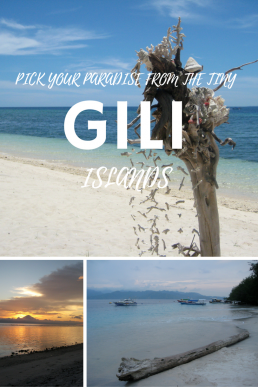
Valencia’s Old Town Merges Famous Sights With Street Art
Valencia boasts one of the largest historic centers in Spain. The narrowest alleys are concentrated in a small area of the old town called Barrio del Carmen. This very same maze hosts a bustling nightlife, various subcultures and some of the biggest sights of the city.
Mecca for Artists, Punks, Hippies and Gays Alike
Barrio del Carmen, or simply El Carmen, blends the city’s Roman and Arabic roots with Spanish modernism. Just like architecture, the residents present quite a colorful mix – from well-dressed ladies to immigrants, punks, and hippies. Bohemian vibe attracts artists and party-goers. Many of Valencia’s gay venues are concentrated in El Carmen, although nowadays Ruzafa might be the more hyped gay neighborhood.
Get Lost to Find El Carmen’s Real Charm
El Carmen consists of old town roughly to the north of the Plaza del Ayuntamiento, which is the main square hosting most of Valencia’s administrative buildings.
Calle Caballeros (Knight’s Street) splits the quarter in half and is considered as El Carmen’s main street – so this is where most tourists trot. My advice is to venture into quirky backstreets to find El Carmen’s real charm: quiet terraces, tiny tapas restaurants, and pubs, orange gardens and old mansions.
Personally, I liked the streets to the north of Mercado Central (the main market). These tight alleyways form a real labyrinth and atmosphere is a bit rougher: houses aren’t so perfectly renovated, street art blooms and tourism hides. Forget the map and just walk on, let every corner surprise you in a different way.
Stumbling upon Street Art
Valencia has a vivid street art scene, which I didn’t know beforehand. If you follow the scene even loosely, you’ve probably browsed the works of Escif – at least on the net. Although he’s globally very active, his hometown is blessed with an amplitude of his art. We saw Escif’s funny pop-up art just off our home street, Musico Peydro. The same spot had some pieces from the world-renowned Hyuro as well. I’ve heard that she’s originally from Argentina, but lives and works in Valencia.
Are You Dead? became our favorite artist, as we stumbled upon his murals several times in El Carmen. It was love at first sight, as I love skulls and don’t mind witty variations on the same theme. El Carmen is the place to hunt the big names and future talents.
The Best Plazas for Lazy People Watching
Plaza de la Virgen and Plaza de la Reina might be the most touristic spots in the city. They’re worth visiting, even briefly, to get those classic postcard shots facing two of city’s main sights: the Cathedral and Basilica de Virgen de Los Desamparados. It’s told that the Cathedral even holds the Holy Grail, the Valencia Chalice! By stepping in both of these churches, we witnessed one mass and one wedding.
Terraces around these two squares are touristic and overpriced, even water bottles in machines cost five times more than in supermarkets. Of course, you can bring your own bottle of good beer and just idle the day away watching locals roller-skating, kids playing and tourists posing. During a few afternoon hours, we encountered several weddings, bachelor parties, and noisy parades.
To get a more modern feel visit Plaza del Ayuntamiento in the southern part of El Carmen. It replaced Plaza de la Virgen’s status as the main square in the beginning of 20th century and has still old (though not medieval) buildings like the town hall and post office. For us, it was merely a walk-through, though a pleasant one, as the square is surrounded by traffic and all those huge buildings make it less approachable.
Charming little squares that pop out around the corners of El Carmen’s old streets have a more authentic feel than any of those listed above. Some of them have terraces, some not, nevertheless they make for a nice break. We picked cakes from one corner bakery and sat down to watch the bustle for a while.
Why to Choose El Carmen as Your Home Base
I strongly recommend staying in old town (and preferably in El Carmen), if you are spending only a few nights in Valencia like we did. We stayed a few blocks from Central Market (Mercado Central) and loved the neighborhood since sights, restaurants, and nightlife were all just a walking distance away.
Our apartment was at a quiet backstreet called Musico Peydro; you can find their booking.com listing here. Price-quality ratio was excellent. Hotels near old town might be a bit pricey for what you’ll get, but there seemed to be nice apartments available. Ours had even three little balconies – perfect for immersing yourself into the beat of El Carmen first thing in the morning.
Pin this story!
